ISOLATION SYSTEMS
There is no need to explain to anyone that using good antivibration feet or platforms under a pair of loudspeakers may project into how the speakers measure and sound. But how does it come that using similar devices under a power amplifier may affect the power output of the amplifier? And why the very same devices may improve the sound of D/A converters or power distributors? This article is not a review - rather it outlines different paths that you can follow to improve the performance of your audio system. Often the effect of isolation devices is nothing short of magic.
This article has no ending as it is expanded with new isolation devices every time Audiodrom has an opportunity to test them.
REV 0 - Original text - 04.2015
REV 1 - Nordost Sort Kones - 10.2015
REV 2 - Stillpoints - 06.2017
REV 3 - Ansuz Darkz - 04.2020
REV 4 - Stillpoints Component Stand SS & Townshend Seismic Podiums - 07.2020
REV 5 - Synergistic Research UEF Performance Elevators - 04.2021
REV 6 - Shunyata Research DF-SS Dark Field Suspension System - 08.2021
REV 7 - Synergistic Research MiG 2.0, Stillpoints Ultra 6 V2, AAI Maxi - 11.2021
REV 8 - Hifistay - 02.2023
REV 9 - AAI Ultra 4 - 10.2023 + 12.2023 update
REV 10 - Stillpoints Ultra 6 V2 revisited - 07.2025 update

Earthquaking
The earth trembled and quaked, and the foundations of the mountains shook... (Psalm 18:7)
I have been into hi-fi and high end for last 20 years. You know, as time progresses a reviewer is less and less surprised by what he (or she) hears and becomes less excited about new things coming as they actually are (usually) not game changers. New models of speakers, cables or converters are like an endless river - they are coming and leaving, they cause some ripples but they do not change the river's flow.
If I skip the teenage years of audiophilia, I got really heated up only twice during last 10 years. For the first time when Audiodrom started to review power conditioners and power cords. The original idea of testing few power cables resulted into a huge test of dozens of aftermarket cords that was published in our comprehensive Power Up! series of reviews. It was the moment when I fully realized how essential effect on the sound the way we power our components had.
Similarly, when Audiodrom started to review aftermarket antivibration feet it was just a peek into a not very interesting voodoo area of the high-end. Oh boy, were we totally wrong! More and more we discovered the effects of different antivibration philosphies and more and more we were stunned by vast (not always) improvements in sound.
Then again, there is no need to explain to anyone that using good antivibration feet or platforms under a pair of loudspeakers may project into how the speakers measure and sound. But how does it come that using similar devices under a power amplifier may affect the power output of the amplifier? And why the very same devices may improve the sound of D/A converters or power distributors? This article is not a review - rather it outlines different paths that you can follow to improve the performance of your audio system. Often the effect of isolation devices is nothing short of magic.
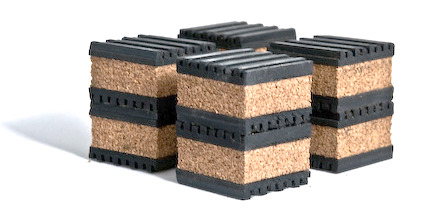
High End Energy
The whole thing - the hi-fi - is about energy transformations. Mechanical, kinetic, electromagnetic, acoustic, heat, light - perhaps just nuclear energy is missing in our hobby. The audio chain is an open system with a lot of interactions with environment - it is difficult to foresee how EM interferences or particluar room settings will affect what we will be hearing.
The trick is that the laws of physics do not count with energy annihilation, the energy can be conserved or transformed but not wiped out. How can we remove peaks in the acoustic response? By transforming the sound waves into heat with the help of absorbers. what can we do with light? We can transform it into an electric signal in an optical converter. Where does the power dissapear in Class A amplifiers? It is transformed into heat and dispersed by heatsinks. It is a closed energy chain.
There is not much we can do with what is inside an audio component; let's assume that we purchased it for we liked how it sounded with no intention to rewire it or rebuild its chassis. This applies to source components, amplifiers, DACs, power filters, laptops or speakers. What we can do is to look on the way how the component interacts with its surroundings. Think about examples like antivibration decoupling or floating of turntables, changing the component's power cord, placing speakers on spikes, or putting heavy weights on top of the components. Or you can check what aftermarket component feet can do for you.
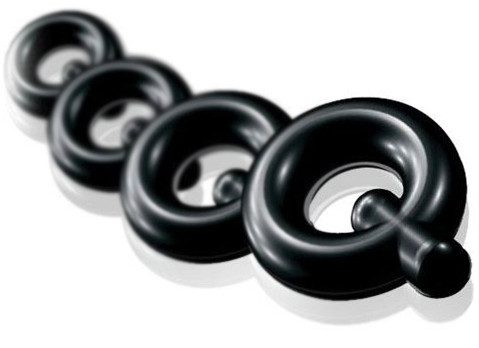
Isolate!
The common sense says that the components must be isolated from each other and from anything else. This belief is rooted in analogue world - the floating turntable is less prone to needle skipping the same way as the industrial stamper must be decoupled from floor not to induce tremors in the workers. The more the component 'floats' the better the sound will be, the logic says. Or not?
The principle of soft isolation is used by most devices. Some typical examples may include different Sorbothan pucks or Q-Foot from Audioquest, American Vibrapods, Bright Star Audio Isonode or Black Ravioli BR Pad. Just search internet and there are dozens of similar devices that should help your audio float. Some may help, some may harm. I only see two issues with the soft feet:
First, if the bias of nice looking accessories is excluded (laser cut logos look so nice), the same effect can be ensured by using daily life items at a fraction of the price: rubber and cork washers and plugs, felt lining, foam balls, springs, sand boxes and bags, different gels... there are hundreds options out there that cost nothing so it is a big playground for experimentation. Yet, if you really encounter a properly designed set of antivibration feet, I can guarantee you that all your DIY stuff will be disposed right away.
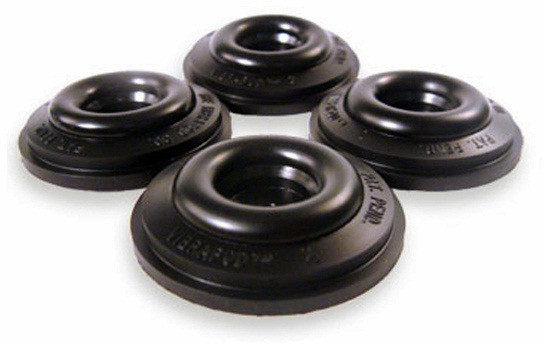
Second - the more relevant - issue is the principle of the soft feet. It is like trying to prevent wicking moisture in the walls of a house. Common sense says to isolate the house walls and cover them from outside with tar not to be in contact with soil. Well, it works until the mositure somehow gets behind the tar - and you bet it will get there somehow. Then the tar prevents the moisture to leave the walls. The same is with vibrations in hi-fi.
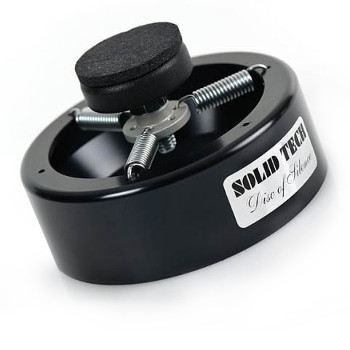
Any soft feet’s task is to prevent the resonances to travel between the component and the surface. Stomp on the floor and the floor’s vibration will not be seen by the component. Play some throbbing music and resonances of speakers will not mechanically leak into the electronics. That’s fantastic, isn’t it? Well, it depends. For a turntable the rather floating decoupling is needed otherwise the pick-up mechanism picks also the mechanical resonances from surroundings. Similarly some commercial CD players may be sensitive to a resonating rack or shelf. Amplifiers and D/A convertors – not speaking about a power filter - should be less or not at all sensitive, in theory.
The problem is that it is not a stomping audiophile who generates the resonances, the enemy is within the system – the music itself. The mass of compressed air travels and penetrates deep into all components, no matter whether they rest on some kind of feet or are hanging in the room on nylon strings or levitate on magnetic pads. It is naïve to think that aluminum case or sorbothane feet prevent 40Hz wave to enter the electronics. There is only one way to fix this, though impractical: place the electronics in a different room than speakers.
So what happens if we place an (already) resonating component on soft feet? The resonances will stay trapped in the case and will be gradually dissipated through the PCB’s, wiring and mechanical parts. This way the soft isolation feet appear to be the worst case scenario, because they will impair the temporal domain of the music playback.
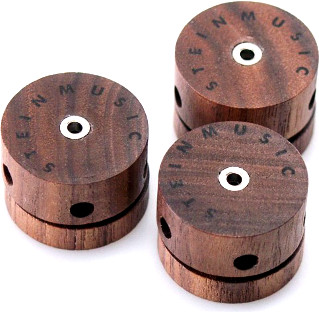
Temporal disorder
Let’s take any loudspeakers. I am always surprised at how much we try to to make them sounding flat. Ask the nearest passionate audiophile about what he thinks he hears in his listening room and you’ll be presented a measured frequency response with negligible deviations from a reference dB level. And if this is unachievable by room’s acoustic treatments then an electronic room correction device is called to arms. I do not object to achieving the flat frequency response at all, yet I see it as one of many factors that contribute to a good sounding audio system. We have discussed this topic in our article MEASURING SPEAKERS - HOW FLAT SHOULD A FLAT LINE BE? If the measurements should tell you something more it is needed to add cumulative spectral decay plot and impulse response, as minimum. Unlike the frequency response they include an extremely important parameter: time.
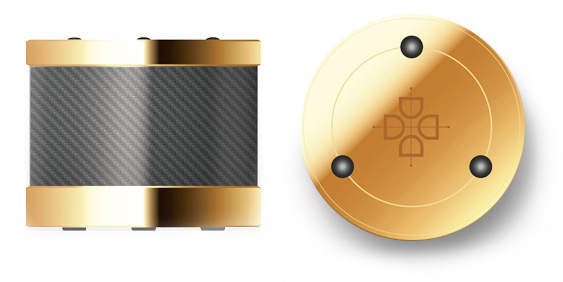
Music is a dynamic event, changing every millisecond. Should the playback be identical to the program on a disc or a record the signal should only be present at your ears for exactly the same time period as it is on the medium. This is of course nonsense, the playback chain and the room add hundreds of phase shifts, smears, energy losses and energy build ups. By reducing those distortions we are getting closer to the original, and the last thing we want is to store energy in the system so that it could be released milliseconds or second later.
Badly damped speaker enclosures may ‘ring’ seconds after the tone burst is over. The wooden floor that resonates in the rhythm with music. A big wardrobe in the rear corner that works like a giant passive subwoofer. And the soft isolation feet. Most of the energy that is absorbed by them cannot be drained otherwise than returned back to the electronics a fraction of second later. This causes smears, blurred transient response, fluttery or dull treble, or losing definition in bass.
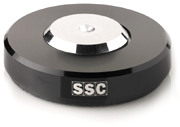
Some soft isolation feet try to fight this energy accumulation. Disc of Silence or Isolclear by Solid Tech, or AS Puck and Netpoint by SSC are such examples. Solid Tech uses an isolation pad suspended on springs, SSC uses strings or membranes. Both the solutions work fine, none drains resonances effectively away from the electronics nevertheless.
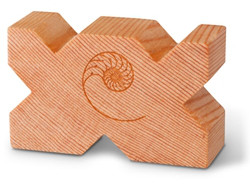
How about wooden blocks? Although wood is much harder than foamed materials its function depends on how it is tuned. Yes, tuned. The wood sounds which can be easily tested by hitting wood blocks of different sizes and wood types. Each resonates, some more tunefully than the other. Soft woods are like any other soft material, hard woods may yield interesting results when placed under the electronics – think of Cardas nd Ayre myrtle blocks. With the wooden block the resonances are not damped (unless the wood resonates at the very problematic frequency that you want to tackle), rather they are overwritten by the block’s own signature sound. This is the reason why wooden instruments now sound so ‘woody’ in your system. The problem is that a saxopohone sounds woodier too. Some woods, like bamboo, damp the resonances quite well thanks to its fibrous structure. So my experience says that with any wooden isolation blocks and feet it takes a lot of experimentation which may or may not give a good result at the end. Most after market wooden accessories are colorants a sort of, unfortunately.
Imagine that you are a top athlete. Would you wear a cotton sportswear that absorbs some sweat and then stops to convey the moisture, or a syntetic windstopper that makes you swim in your sweat after first 200 meters? Modern sportswear works like a membrane that lets the moisture out and does not let the outside weather in. With isolation feet the principle is the same. You don’t want to prevent the internal resonances to get out, you don’t want the external resonances to enter the system. The goal (and challenge) is to drain the resonances away and don’t let them get back.
Some isolation and anti-vibration devices can do exactly this. Let’s see how they can catapult your audio into a completely new performance level.
Gravity
I use to read at audio forums: Your system is not expensive enough to hear the things. Or, your system is too expensive so you don’t know what to listen for, like every snob. It’s like Joseph Heller’s Catch 22. Still, improvements in sound with right feet that are properly placed are easy to detect. It is true, however, that one has to have a bit more than standard acoustics and electronics that do not mask those improvements by their own flaws.
Once we leave the kingdom of rubber and foam absorbers we enter the kingdom of metal. The king is old and liked almost universally – it is a metal spike. The spikes are cheap, easy to get, easy to mount, and they work. I do not know any audiophile who would not live with the spikes under his loudspeakers at least for a while. The idea behind the spikes is simple – the weight of the speaker is focused onto a tip (usually four or three tips for one speaker). Thus the force from the tips to floor is much higher than it would be with flat feet and the resonant frequency of the whole system shifts. How? It will depend on the floor or the contact base for the tips. Non-resonant materials (concrete, sandstone, etc.) are usually splintered by spikes under the load of heavy loudspeakers so one can choose from harder materials that have their own resonant frequency, depending on their size and thickness (granite, marble, glass, steel or different composite materials). The result must be tested and cannot be foretold, with maybe the glass being an exception – it sounds bad in 99% of cases, no matter where it is. It is pitiful that glass shelves are used by many manufacturers of lifestyle furniture. In hifi, however, nice looking materials are usually the worst option.
A ceramic ball revolution
German Finite Elemente arrived to the aftermarket isolation feet with a clever solution. They were not the first to employ a ball instead of the spike but their Ceraballs commercionalized this approach effectively - if it is possible to talk about commercionalization in such a niche like audiophile market.
The idea is quite simple: the energy exchange between the component and the base works in both directions but well designed hard feet should be as much as one-directional as possible.
In real use the load on the Finite Elemente Ceraball is mostly axial so it can’t really prevent a part of the energy bounce back. Yet, the part that is ‘drained away’ to the part that is ‘returned’ is much better, at least much better than with the spiked solution. To prevent damping the ball should be as hard as possible, hence ceramics.
The offer of Finite Elemente starts with one-ceramic-ball budget feet like Ceraone, Cerapuc and Ceraball. The last one became, contrary to its quite high price (50€ per piece) quite popular because it worked well. The step-up models like Cerabase Classic, Compact, and Slimline, employ three balls each to distribute the axial load in the radial fashion.
The ‘Ceraball effect’ on sound is a positive one and I have never encountered a set-up that would not have profited from it. Expect better transient response, better dynamic behavior, improved attacks, longer decays, more transparent soundstage and more precise imaging. The magnitude of the improvement is dependant on many other factors but if you just give it a try and replace the loudspeaker spikes with Ceraballs you should notice it immediately. Once heard there will be no way back and you’ll be another victim of the ceramic ball revolution.
If I move all the soft and springy feet into a ‘ for beginners’ box, then the Finite Elemente’s Ceraball will find its place in the box for ‘ intermediate’. The Cerabase goes from one ball to three, and is a significant upgrade which elevates the performance of your system even further. The multiball solutions have become common since then and before I move on with the very best of them I would like to take a small detour: let’s take a look at how to place the feet under the electronics.
Revolution within the revolution
American Nordost is known as a cable expert. Yet they have a range of quite effective decoupling solutions, marketed like Sort Kone and Sort Füt. They took the Ceraball’s principle (one ball axially) and added another degree of freedom – the ball can move radially to some extent thanks to a loose metal element which is placed between the plastic cone and the ball. This way the piece of gear that is placed on Sort Kones ‘floats’ and dispenses vibrations better than the Ceraball.
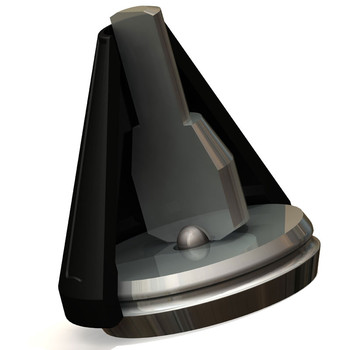
There is even more to it. Nordost found out that the the resonant energy drain can be influenced by the material the metal element and the ball is made of. Thus the Sort Kones come in several grades:
Sort Kone AS – aluminum element, steel ball (70USD/pc)
Sort Kone AC – aluminum element, ceramic ball (84USD/pc)
Sort Kone BC – bronze element, ceramic ball (140USD/pc)
Sort Kone TC – titanium element, ceramic ball (365USD/1pc)
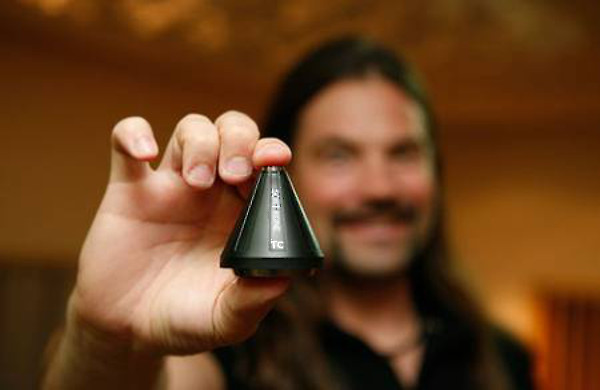
A big box full of Sort Kones spent 3 weeks with me so I used them in any imaginable combination in my system. There were also high-tech looking Sort Füt feet that combine aluminum and bronze with 3 ceramic balls and are to be used under speakers. Unfortunately my Bowers Wilkins 802 Diamond do not support swapping of feet easily, and because the Sort Füt have no plain surface I could not use them under the speakers. I tried them with their tips up under electronics and to my ears they were pretty much comparable to Ceraballs. The inverse placement that I used is not recommended by Nordost and by now you should already know why.
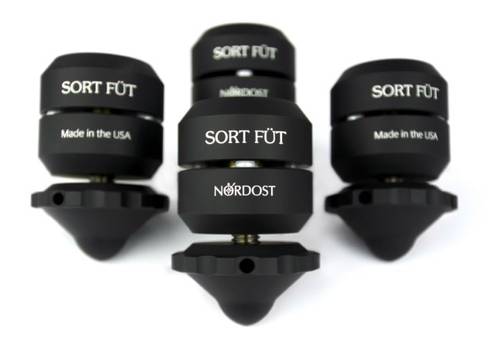
I will be now more specific about what I heard with the Sort Kones in some combinations. To asses the sound I used my (then) Accuphase set up of a preamplifier, power amplifier and SACD player, powered through Nordost’s modified Thor power distributor. I also tested the Sort Kones under speaker cables (plenty of them were on hand due to a running mega-test) and it was quite interesting to hear how some of them were sensitive to this type of support.
Changing the sound
Before I began I formulated a logical approach: I will try the AS feet under all components first, then the TC. The difference in sound should set the lower and upper quality limits between which the rest of the Sort Kones, the AC and the BC, will have to fit. Like with many other assumptions in audio this approach proved not to be workable at all. After several days (!) of swapping the Sort Kones forth and back I made 3 learnings:
1) The exact placement of the Sort Kones under a component is crucial. To generalize, the best sonic paybacks were usually achieved when the Sort Kones were placed under: transformers, IEC inlets, active outlets of the power distributor, and mechanical parts like SACD pick-up. It became also clear where not to place the Sort Kones: under the original feet they made harm, rather than an improvement.
2) The number of the Sort Kones under a component is also quite important. The best number for stability is three, which is the best for your pocket too. One also has to consider that the height of the Sort Kones cannot be adjusted so if your rack (or a component’s base) is not absolutely flat, it will be very difficult to level the component on more than three cones. The bad news is that the best results I mostly achieved with 4-5 Sort Kones under one piece of equipment.
3) There is no relationship between the performance and the price, at least after if you make the evaluation properly. Going up with the Sort Kones, from the AS to the TC, surely improves the sound short-term, yet the result may not be listenable long-term for the sound may become too pristine and over-accurate. Of course your ears will be the final arbiter.
To illustrate the above points I will now describe what I heard with my SACD player. All the Accuphase’s top models (DP-78, DP-85, DP-600, DP-700, DP-720) do have similar internal architecture: dual power transformers at the back, an IEC inlet on the right, the optical pick up in the front middle.
3x AS. With this placement, under both transformers and under the pick up, the sound was great. Comparing to the original feet the sound become more organized and contoured, and the bass gained extra energy. When I put three Finite Elemente’s Ceraones in the identical placements they still managed to better the original feet, yet the sound lost fine microdynamic contrasts and became rough to my ears.
The AC Kones instead of AS Kones improved the dynamics and contrasts, the music had subjectively quieter backgrounds and longer decays. Instrument separation improved too. I liked this combination.
With the very same 3x AC Kone placed as pictured, the sound became ‘slower and smeared’, as if the music had to pass through a viscous matter. The dynamic drive was partially lost and my engagement with the music dropped. When I removed all the Sort Kones and let the SACD player rest on its own feet, the sound improved.
The 3x AC Kone plus 2x AS Kone. The additional two AS Kones were placed at the spots where I felt the best contact with the player’s base. The player, already resting on the 3 cones understandably exhibited a slight ‘flexing’ of its base so the aim was to support this unevenness.
By doing so I could not detect any improvement to sound until I started to increase the playback volume. With the 5 Sort Kones I could play much louder than before and the sound remained composed and controlled. The attack was not softened and the decays not disturbed by the artifacts, possibly caused by resonances, that were present with only 3 feet under the player.
The 3x BC Kone. The sound became harmonically richer as if the feet added some extra aliquots to the tones. However, the decays were maybe too long, the piano was too colourful, the transients were more liquid and less accurate, as if the fragile balance between the tonality and timing was impaired. After listening to the BC’s one full evening I decided they were not really an improvement in the right direction.
The 3x TC Kone. Wow, what a change! Is this the ultimate solution? I know, readers expect me to formulate similar words of praise, but I have to disappoint. The titanium and ceramics combination had something to it – especially tonality became more vivid and colourful, not in the BC way, rather it became more natural and accurate. As if everything became more organic with the TCs. However, it was not a qualitative leap, rather a small step when compared to the cheaper Sort Kones. Quite interestingly, when I complemented the three TCs with another 2 ACs (like I did with the AC/AS combination) I heard no difference. To me the Sort Kone TC is an extremely good product that follows the law of diminishing returns: the substantial extra cost delivers a little better performance.
A never ending ride
The 3x Sort Füt upside down. The sound was similar to TCs. I appreciated a tad more detailed presentation on some recordings, though not on all. The Sort Füt were not designed for electronics and they are too tall for such application, however I can imagine to use them on sides of an amplifier platform, for instance. Other than that they may work well with speakers.
From what I described the best fitting Sort Kone mix for my player was the 3x AC and 2x AS combination. I did the same exercise with the preamplifier and found that – once again – the Sort Kones did their job the best under the IEC inlet and the transformer. This led to an assymetric placement where tehe 3rd Sort Kone was used to balance the two under the IEC and the transformer. When I moved any of the feet by 2-3 centimeters the sound lost focus a bit.
It seems that by combining different types of feet in certain placements one can manipulate sound to some extent. The trick is to persevere and find the combination that hits the proverbial sweet spot. I also found that a 50Hz range is the most prone to feet manipulation, perhaps because it is the AC mains frequency.
To make the long story short I found that – with the preamplifier – three TC Kones were giving me the best satisfaction. The sound was dynamic, detailed, and alive. Coughing of the audience was realistic as was the piano that was strong, ringing and had vivid colors, no matter how loud I was playing. Which is another interesting phenomenon – increasing the average listening level by as much as 5dB just by using aftermarket component feet is a remarkable achievement.
Replacing just one TC for any other Sort Kone was a step back. As of the trinity of the TCs refused an intruder, the sound was worse than with all three TCs replaced. Going back to the three ACs the sound became subjectively more ‘sticky’, slightly veiled, and dynamically flatter. With the three ACs the impression of observing the music through a dusty pane was even stronger. Once I experienced the clear view it was impossible to go back to the dirty one. Call it a highend trap.
Both the Ceraone and Ceraballs were inferior to the Nordost’s Sort Kone solutions. With the Finite Elemente the sound was more diffuse, had softer transients, and just a bit more compressed dynamics. I was also consistently noticing that whenever the Ceraballs were under the electronics the soundstage got deeper in a long narrow “U” shape. This was rather attractive with most reordings, and not so attractive with solo instruments recorded at a dry booth acoustics. The Cerabase had not exhibited such coloration - I will be back to it later.
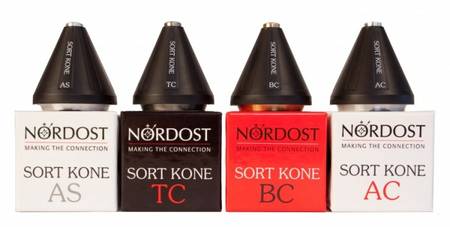
Stabbed in the back
The so far smoothly running review process had become much wilder once I sorted out the source component and the preamplifier and moved on to the power distributor. My modified Thor rests on something that is best described as blunt spikes resting on concave polymer cups. Placing the Thor on the three AC Sort Kones was heard as no change, bordering very slightly with detoriation. The sound became less powerful in fortissimos and became disorganized earlier with increasing playback volume.
With the three TCs the music was more distinguished and I could detect better colors of cello, or weightier and fuller double bass with improved contours at the same time. The real surprise was yet to come, however.
The bronze Sort Kones BC became forgotten in the course of the review process for they never excelled. Before I finally packed them I put them under the power distributor, for sheer completeness of learnings. I was not ready for such a surprise. The bronze feet transformed the sound in a single a gigantic leap; the Harry James ensemble suddenly materialized in the room with all the blazing horns, saxes and trumpets, the drum rolls became explosive and trained the speaker cones with huge dynamic swings. Also the top end got alive with shimmering cymbals and new-found details and decays. I could hear players breathing, I could sense the bass moving my shirt. All these wonderful things remained there no matter how loud I played the music, until my ears started to protest due to high SPL. I got back to the experiments with the other Sort Kones but no matter which combination and number of ACs and TCs I tried I never quite achieved the richness and completeness of the BCs. Also adding any other Sort Kone to the three BCs impaired the sweet balance.
It seems that there are improvement areas in hifi that are unexplored in full. Yet the very areas can significantly contribute to our listening experience. The experiments also prove that leaving any biases and prejudices behind really helps; it is only the result – not the price or promo materials – that tells us what is good in our systems and what is not.
On the other hand it would be unfair to wave off expensive devices just because they are expensive, hence only for highend snobs. Let me take you to the realm of some really expensive feet that not only meet the expectations, they surpass them.
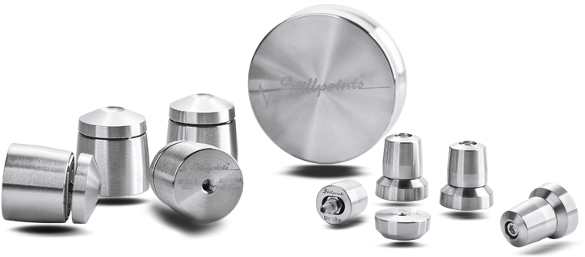
Mechanic diode
They look high-end at first sight. They look high-end at second sight too. The Stillpoints supports are deceptively simple stainless steel devices that feel heavy in hand and feel heavy on any expenditure list:
Ultra Mini – load up to 25 kg - 135€/pc
Ultra SS – load up to 450 kg – 266€/pc
Ultra 5 – load unlimited – 745€/pc
The Stillpoints take the original idea of hard ceramic ball between two metal pieces a bit further. As we discussed already, the energy transfer happens both axially and radially, there and back. Stillpoints try to break the return path for the energy and only allow to drain it away from electronics.
The solution of Stillpoints uses several layers of ceramic balls of different sizes (in more sophisticated arrangements as price progresses) that are placed radially towards the perimeter in aluminum and Delrin segments (Delrin is a DuPont polymer material). The whole feet assembly is encapsulated in the outer stainless steel “cockpit” that cannot be opened without tools. The goal is to allow the resonance to travel from the tip to base and further to the shelf or floor, and prevent them bouncing back.
I had lived with two sets (2 x 2 x 4) Ultra Mini and Ultra SS feet for two months, this period slightly overlapping with the Nordost Sort Kones. When the Stillpoints arrived all the listening tests with the Nordosts were already finalized and the system was “mechanically equalized” to my full satisfaction. I did not expect any further improvements, perhaps only some minor fine-tuning. I started with swapping all the 3 bronze Sort Kone BCs under the modified Thor conditioner for 3 Ultra Minis.
A train the the room
The Chesky Records testing disc features some nicely recorded environmental noises, and Freight Train Crossing is one of them. Don’t expect anything else than a field recording of a freight train passing the microphone, the sound that si presented with massive and deep mechanical rambling and screeching. Depending on the electronics and speakers that are in use, the train is heard as sometimes more sometimes less intense noise that makes the walls of the room resonant. With the Stillpoints Ultra Mini in place the sound of the train seemed quieter than usual, so I had to add 2-3dB (!) to achieve the same perceived loudness in the room. Then the train blowed its horn. I knew the horn would blow, I heard it many times before in the very same listening chair. This time I jumped up to ceiling – it was as if the real train was passing right in fron of me. Incredibly dynamic sound!
Okay, it was time to place the Sort Kones back. I loved what I heard but the moment passed without a surprise. I swapped to the Stillpoints and, again, my heart stopped. Come on, with three pieces of stainless steel?
After this is I spent days and days by trying the Stillpoints in many different combinations under all my components, I took them with me to a studio, to friends, to anywhere I went. No matter where they always delivered – the articulation got improved, the transient attack got improved, the subtlety of resolution got improved, the dynamics got improved, the music sounded more resolved and cleaner. With some Reference Recordings disc my amplifier is taxed by as much as 220 watts of transient power. The max reading I got with Dynaudio Confidence C4 II (250 Watts) and Bowers & Wilkins 802 Diamond (235 Watts). If I played any louder the sound started to collapse. With 3 Stillpoints Ultra SS under each speaker I could not find the volume setting when I would not like the sound. When I caught a glimpse of the amplifier’s VU meters they read 330W one Friday evening. Without congestion, everything fluid, resolved and under control.
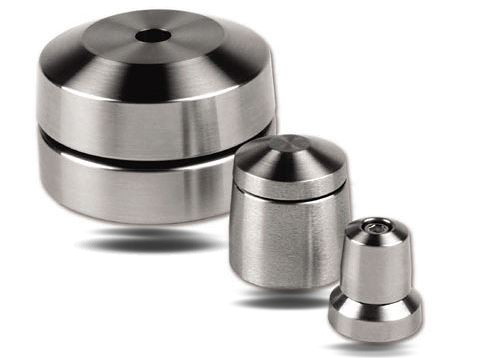
The Stillpoints Ultra SS
The Vaquero track (Opus 3 Showcase, Opus 3) features a steel guitar. With the Ultra SS’s under the speakers the guitar got more visual, it was more accurate and sang better. It was like on the clear winter day when you see pine cones on the tree hundred meters away. The accuracy was not a trade off here, there was no thinning of the sound, the bass and timpani were as weighty as they were before, yet they became more vivid in the soundstage. Without the Stillpoints the sound got polluted by some smog, as if the formerly sharp contoured lines were a hair out of focus. With the Stillpoints the transient bass pulses of Sade’s No Ordinary Love (Love Deluxe, Sony/Epic , 500598-2) were amazingly deep and resolved at any volume setting. So deep that my spouse ran upstairs to tell me that the glasses in the kitchen were moving in cupboards.
If you place the Ultra SS feet under electronics you don’t need a blind test to tell the difference. The with/without difference was also clearly heard if the Stillpoints were replaced by something soft, like sorbothane pucks. It also became clear soon that the Stillpoints do not like combinations with other feet and that (with some rare exceptions) worked best without any soft padding below them, no matter how thin. The latter is intuitive – if the energy should just pass through the feet and away from the components, there should not be any springy material that would conserve it and return it back a millisecond later. So a combination of Stillpoints Ultra SS with SSC Netpoints was worse sounding than SSCs alone.
The Stillpoints Ultra SS versus the Finite Elemente Cerabase
This was a crucial comparison for me as the Cerabases are my resident supports under the speakers. For the final comparison I chose two tracks from Audio Lab label’s treasury. The label made some exquisite audiophile grade recordings back in 70’s and these are now available on Octavia Records hybrid SACDs. Usually they are simple jazz numbers, with instruments recorded uncompressed, DR 16-18.
For example, The Dialogue (OVXA-00008/SCD-1) is a energetic duel of a drum kit and an acoustic double bass, recorded on four microphones. Don´t be That Way (OVXA-0003/SCD-1) adds a piano and five saxophones. With the Stillpoints Ultra SS’s the bass showpiece was firm, with fast attacks of plucked strings and deep vibrations of the instrument’s body after that. The initial attack was a tad softer and more natural than one usually heard on audiophile samplers where the instrument usually gets some treatment with compression. The pieces of the drum kit were amazingly accurately locatable within the soundstage and the whole set had palpable three-dimensionality that did not change with the playback level. I also could point my finger and say this is the tenor sax, there is the alto, the piano is oriented this way… It could hardly get better than with the Stillpoints in place. I wished the Cerabases had been at least comparable. Why? Ask my bank account.
The Cerabase sounded more robust against the Stillpoints. It was as if the musicians were just a bit closer to me and had thicker contours. The stage was not different but its inner resolution was a tiny bit less clear. This was heard especially on highs that lead the spatial information and which brought cymbals that were shimmering with more nuances with the Stillpoints in place. The difference was not large and to arrive to these findings it took endless shuffling with 80kg speakers with the help of my spouse.
With the Bowers & Wilkins, specifically, I would like to add that it was not only important which feet were installed but also where they were installed. The least effective they were at the place of the original feet. The best result I git when two Stillpoints supported the metal edge in front and the third one balanced it at the rear of the speaker. In this position also the Cerabases sounded their best. Luckily I could easily live with one or another set of feet under the speakers, although I admit that the Stillpoints were a pinch of salt better.
The Stillpoints Ultra SS versus the Ceraball versus the Nordost Sort Kones
Well, any discussion about whether and how replacement of a component feet can have an affect on how it sounds ends with the Ultra SS. It is not just different, it is a transformational and dramatic change. Comparing the Ultra SS to the Ceraball is loss of time; the Ceraballs sounds fuzzy in lows and their soundstage as if was defomed into a long-legged V. I have no explanation for how the Ceraballs resculpt the depth of the soundstage but they do, no matter where and how I placed them.
The duel of the Stillpoints Ultra SS with the Nordost Sort Kone TC was much more interesting. With the Ultra SS under the preamplifier the sound became so much better articulated and vivid that the Sort Kone TC could not compete. But there was something else that left me completely puzzled. The Accuphase A-60 power amplifier has precisely calibrated digital VU meters that show its momentary power output on the fly. With the Stillpoints Ultra SS under the preamplifier these VU meters showed 6dB lower peak value than when the Ultra SS were removed, and no, I did not touch the volume knob. I left Ciao (Harry James, Sheffield) on repeat in the player and swapped the Stillpoints with the Sort Kones several times, always with the same result. Then I disconnected the speakers to remove the major source of resonances in the room and performed the same exercise again with the very same result. Even without listening, just by looking at the Accuphase’s peak voltage meters, I could reliably tell when the Ultra SS were under the preamplifier.
The Ultra SS did all the good things to the sound – they sounded cleaner, more accurate, and more assured. However, subjectively they also as if drained some low end energy away from the playback chain. For example, the deep bass in Arabian Desert Groove (Charly Antolini, Knock Out 2000, Inak 9053 CD) lost a bit of its seismic energy. The piano in Dvorak’s Dumky, though wonderfully focused and diabolically contoured with the Ultra SS, became a tad less rich and colorful. I acknowledge that the Sort Kones TC were slightly ‘smeared’ and less pristine sounding in comparison, but also less technocratic and a bit more real thing.
The Stillpoints Ultra Mini
The most modest looking Stillpoints Ultra Mini appeared to be a good compromise, at least in the context of my system. They did not have so perfect highs like the Ultra SS, yet they managed to keep a big part of the air and resolution of the SS and preserved the physical weight of the bass. I would love to have everything, the color, aliquots, deep bass and crystalline highs, but whathever I did with all the different feet on hand and no matter how I combined them the Ultra Mini seemed to exhibit the best synergy with the preamplifier.
Interestingly the things were different with the SACD player. Any Stillpoints combination introduced extra spark, speed, clarity and other accentuation but the sound became maybe too precise, too sparkling and too clean. It took me three days of going back and forth to end up on aforementioned combination of the Sort Kones (3x AC and 2x AS) which sounded balanced to my ears. I also noticed that while the SACD players was firmly anchored on the Stillpoints it was a kind of floating on the Sort Kones which allows some radial movement. Can this be a reason? Perhaps the rotating disc in the player’s transport asks for different distribution of (supposedly bigger) forces in its chassis than rather stationary amplifiers or power conditioner.
Ansuz Darkz - forged by gods
Ansuz Acoustics, located in Aalborg, Denmark, is not a new name in business (see Nordost, Raidho, and Aavik for reference; all benefit from cutting-edge solutions of the Ansuz’s masterminds, Michael Borresen and Lars Kristensen). The guys in Ansuz are huge proponents of “mechanical grounding” through their modular Darkz feet.
The Darkz are, once again, a variation on the hard ball between hard surfaces. The Ansuz team went a step further and in collaboration with Aarhus university tried to achived extra grades of hardness with the help of a particle accelerator.
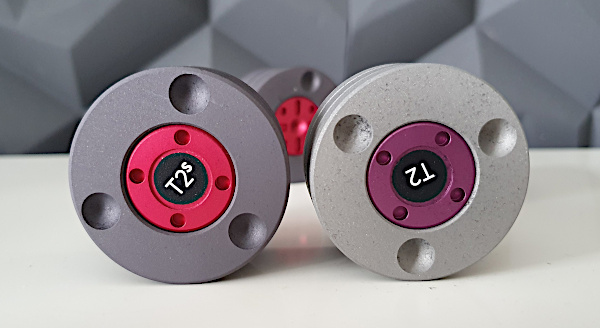
The Darkz are a composite of three metal rings, one above other, that interact via three balls in between each two rings. Each Darkz feet thus employs 2x3 balls. Then there is a central segment that holds the while assembly together. The balls can slightly move to sides so the whole system is allowed to float in all directions. Despite the Darkz are quite heavy they feel fragile in hand as everything is moving, yet not disintegrating.
Depending on the surface treatment the Darkz are available as C2 (anodized aluminum), D2 (hardened aluminum), and a T2 (even more hardened aluminum surface). The top of the range is occupied by the Darkz T2 Supreme (the Darkz T2S) that use three titanium rings, each treated slightly differently. Ansuz claim that it takes 60 hours for the particle accelerator to achieve the final specification of the surface.
Are the Darkz anti-Stillpoints?
The distributor (RP Audio) shipped several sets of the Darkz T2 and T2S. I used them everywhere I could, except the speakers. My speakers are ‘mechanically grounded’ with the help of a custom solution that includes modified Finite Elemente Cerabase feet, unfortunately not removable. I could work around it but doing so the concentric tweeter/midrange driver of my TAD speakers would change its relative position to my ears and would interact with the room acoustics in a different way. So the different sound it would be, but not thanks to the Darkz.
I would not say that the Darkz’s effect is far from the Stillpoints, they preserve, let’s say, 80% of the Stillpoints’ goodness. This means that the sonic contribution of the Darkz is clearly heard from a first bar of a music. The improvement is substantial and as transformative as with the Stillpoints. Try it and if you fail to notice a difference in sound then it is time for you to stop investing into audio gear. The Darkz improve everything; the bass is tauter, the spatial information more precise, the soundstage expands to the sides and to the back, and the sound becomes more articulated, vivid and colourful, like it happens with the Stillpoints. Yet the Darkz can elevate this performance even higher.
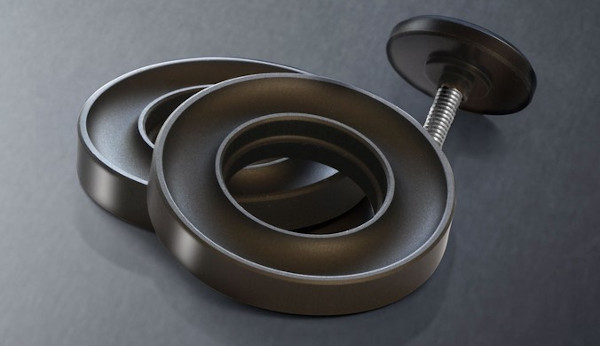
The Stillpoints make the sound more present, more brilliant and transparent at the same time. The music through the Stillpoint as if had better immediacy, better 'thereness'; with them horns are raspier and violins more stringy. The Darkz, though in the same rank of accuracy, sculpt the sound in a bit different way. They turn down the spark of the Stillpoints a shade or two without sacrificing the smallest bit of transparency, and make the music fleshier at the same time. With the Darkz the music is more relaxed and full of vivid colours, yet still extremely resolved and with an otherworldly rhythmic drive. The sound seemingly exhibits bigger dynamic headroom as if suddenly your amplifier doubled its power reservoirs. Are the Darkz better than the Stillpoints? Well, try for yourself, I would say yes, they are. However, make this investment only when you think you won't be changing electronics or speakers any soon. The Darkz are expensive and if you still plan to replace some other component then I assume it is better to increase the budget for e.g. a new amplifier rather than buy a compromised one and place it on the Darkz.
Watching the Darkz
I spent several weeks with the Darkz and there was not a single piece of equipment that would not benefit from them. I loved what they did with my subwoofer's sound, the bass got tighter and punchier. The function of the Darkz, that is decoupling the subwoofer from the floor, was easily demonstrable - when I placed my hand on the floor next to the sub I could feel much less vibrations than without the Darkz. But I will be back to this because right after the Darkz another fantastic decoupling device arrived.
High end is about exploration so I did not resist and tried the Darkz under power cables. Two Darkz under my Synergistic Research Atmosphere Level 2 power cable (the one that connects the wall socket and the power conditioner in my system) made me do a quick calculation whether the family budget could afford them. They were like revelation, virtually everything improved. Not that the power cable was just thrown on the floor before - it rested on Ceraballs - still the difference was remarkable.
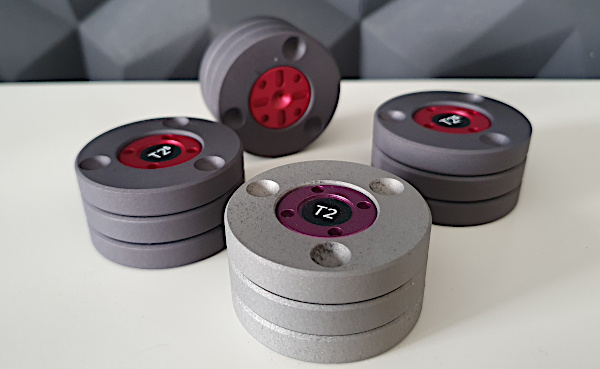
On the other hand I failed to hear any holistic improvement with the Darkz under the Shunyata Research Denali power conditioner. I could hear slightly better delineated frequency extremes but also slightly less fruity midrange. This is not a failure for the Darkz, neither the Stillpoints nor the Sort Kones showed no positive affect on the Denali. I assume that the Denali is sensitively tuned as a whole and these changes cause a kind of imbalance.
Isolation platforms
The guys in Stillpoints never sleep and continue improving their offerings. When a huge (and heavy as hell) box full of the new Stillpoints Ultra 5 V2, Ultra 6’s, and Ultra Bases landed at my doorstep I knew that I would be getting into financial troubles soon. One piece of the Ultra 6 steals a thousand € from your pocket and you will need 3-4 to balance just a single component. The hierarchy is clearly given with the Stillpoints – the bigger and more expensive, the bigger predator. So the Ultras ate the Stillpoints devices that were lower in food chain for dinner. The main difference vs the original versions is the fullness of the sound. If ever someone complained that the Stillpoints are maybe too accurate then the improved models are highly musical while maintaining the razor-sharp resolution.
However, I am not going to rave about the feet again, rather I will focus on a Stillpoints component stand that was included in the package too. This wonderfully coincided with other two types of platforms that visited my listening room, from Harmonic Resolution Systems and from Townshend Audio.
The Stillpoints Component Stand SS
The SCS-SS (circa 2,300€) allows for any piece of equipment to be placed on floor (or any other flat surface). This is very useful in case of heavy and bulky power amplifiers, but may come as a benefit for any other piece of electronics. It is not designed for speakers, yet if you insist it can be used this way too.
The design of the Component Stand SS is derived from the ESS rack, here in much simpler incarnation. There are two versions of it – the one with 3 arms and the other one with 4 arms. The number of arms has nothing to do with load – both platforms can support basically any weight – rather with how many supporting points for your electronics you need. Also keep in mind that having the extra feet in the 4-arm stand will further improve the audible effectiveness of the assembly.
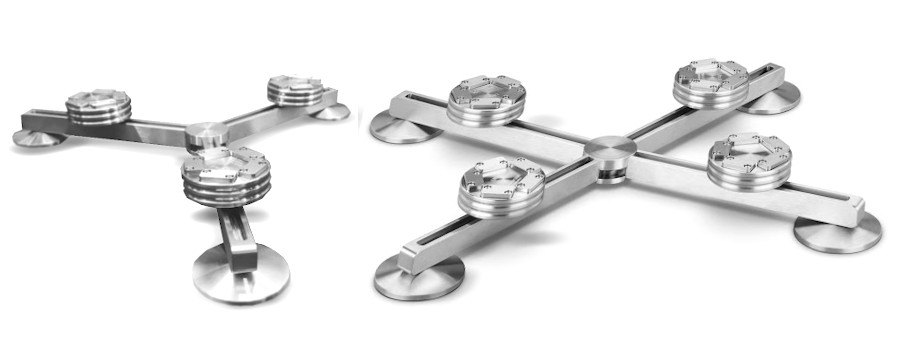
The all standless steel SCS-SS is cleverly designed: there is a central hub to which the arms are affixed/bolted at any angle you prefer. The arms have grooves into which any of the threaded Ultra SS, Ultra 5 and Ultra 6 Stillpoint isolators can be slid and fastened at any position along their length. This actually means that with the SCS-SS stand any device that does not exceed the width/depth of more than 70cm can be supported, so no problem even for D’Agostino mammoth monos. The good thing is that the necessary Ultra Bases are included in the package with the Component Stand SS – the feet of your choice must be purchased separately.
To what extent does the SCS-SS improve the sound? It will depend on which of the Stillpoints the user will affix to it. Then the descriptors that I use few paragraphs earlier would apply here too. But unlike the feet that are an update to the original feet of a device, the Component Stand SS replaces both the component feet and the shelf or floor on which the device is placed. To date I do not know a more effective solution for how to place your electronics on a floor or on a cupboard. I am fully aware of me saying ‘electronics’ rather than ‘loudspeakers’ – for the latter there is another remarkable solution which I will get to in a moment.
I cannot stress enough how important is to properly support amplifiers, sources (no matter whether analog or digital), DACs, power distributors and other gear. The effect of the SCS-SS can be described like that sonic landscapes that would be normally spatially fuzzy, tonally washed out or dynamically dull, will jump into life and become defined, vibrant and vivid. If you like the introspective American/Rubin series of Johnny Cash then you should like Greg Brown’s Over and Under too. With the Stillpoints platform supporting my SACD player all the strings (guitars, mandolin and fiddle) exhibited impeccable transient speed and instrumental decays, while the fundamentals remained strong and tonally full. I could hear the strong contribution of the bottom end that got tighter and punchier with the SCS-SS and this way its previously slight smear that contaminated the midrange too just vanished and cleaned up the rest of the spectrum. If you don’t like racks (like me) then the Stillpoints Component Stand SS is a final solution for your problem.
Townshend Audio Seismic Podium
Pete Townshend has been consistently improving his now twenty years old idea of an ideal platform that would isolate the speakers completely from the floor. The inspiration came from the car industry and his “Seismic Platforms” achieve the isolation by placing damped springs in the corners of a steel platform. The platforms exist in several stock sizes (1,300-1,700€) and Townshend Audio is ready to accommodate your special request and make the platforms in customized sizes if needed. There are also special Sesimic Stands, Seismic Bars and Seismic Corners so that virtually anything including furniture could be efficiently isolated from the floor.
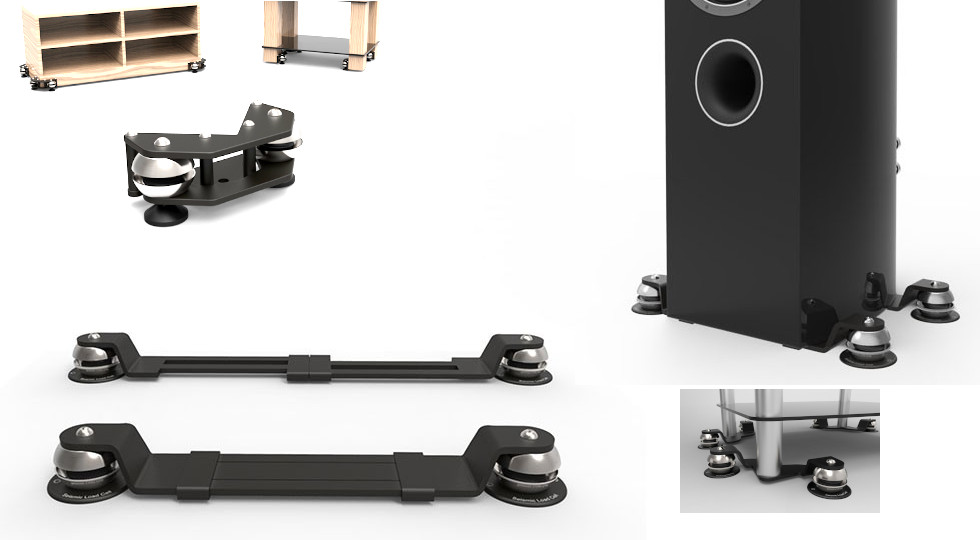
The latest version of the Seismic products improves over predecessors in two important aspects: the podium got much closer to the floor (which is important not to change the tweeter position relative to your ears if a customer is replacing spikes or speaker’s feet with the Seismic Podiums) and the pods in the corners can be adjusted for load and level without necessity to disassemble everything (by turning the top part of a pod tension of the spring suspension inside can be increased or decreased).
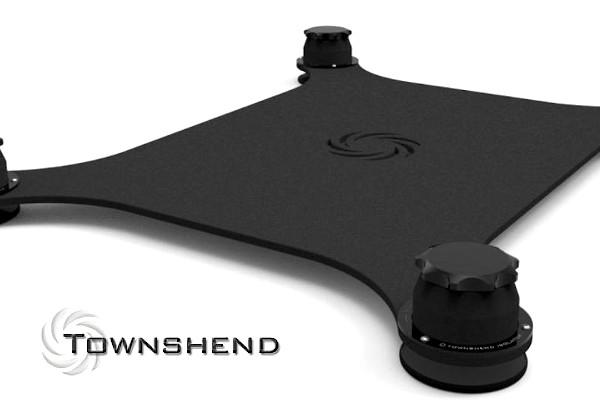
I have not tried all the Townshend Audio seismic products yet, but I was lucky enough to test two Seismic platforms under speakers, and following this super-positive experience I agreed with Townshend they would make a custom-built platform under my subwoofer – the one that I have been using for last 3 months in my system. I am tempted to check what would the Seismic Podiums do under electronics but the special way I have my components placed prevents me to do so and still achieve a reasonable A/B testing methodology. So my findings will be limited to the use with the speakers and the subwoofer.
The sound of the Seismic Podiums is all about focus and silence
Don’t expect the focus that makes sound brittle, nor the tube-like lucidity. In fact the focus of the Seismic podiums is very “un-hi-fi”. You know, when a piano player is onstage 3 rows from me then I hardly ever focus on whether the imaging is right. Why should I, can it be more 3D than having a real person with a real instrument in front of you? I take the ‘imaging’ as granted and rather focus on music. And this is the perspective that the Townshend platforms offer – it is free of typical hi-fi artifacts and wow effects, and its images are not hyped versions of reality – rather it lets you forget that there is any kind of hi-fi.
With the speakers on podiums (vs Cerabases) the piano played by Cyrus Chestnut in Reckless Blues on Madeleine Peyroux’s Dreamland) became more present in the room. The sheer nonexistence of perceived bass bloom and smear removed the last bits of any imaging unspecifity, those that I was not aware of until the Seismic Podiums were employed. Youn Sun Nah’s Calypso Blues from her Voyage album has an intense double bass melody that I could play louder with the Podiums without hearing any negatives in the track’s spectral balance or spatiality.
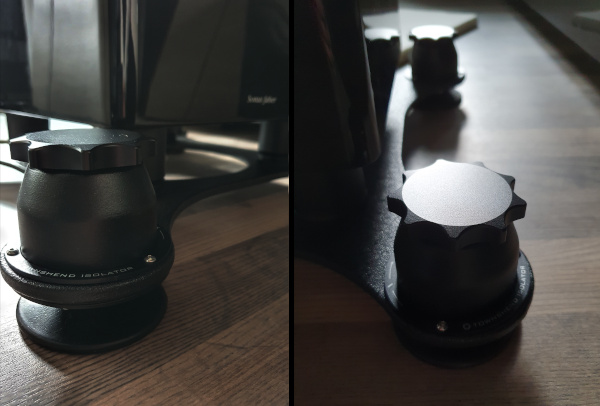
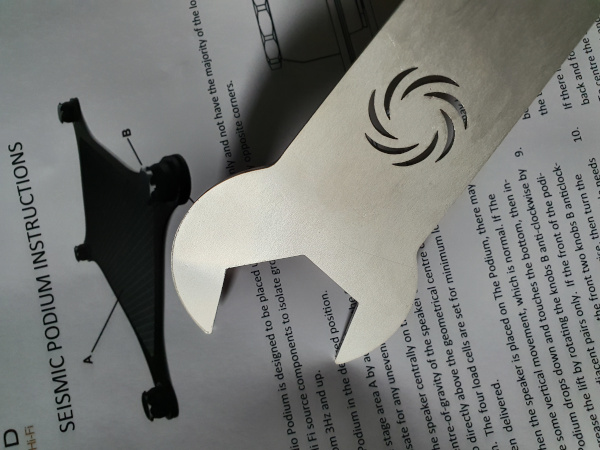
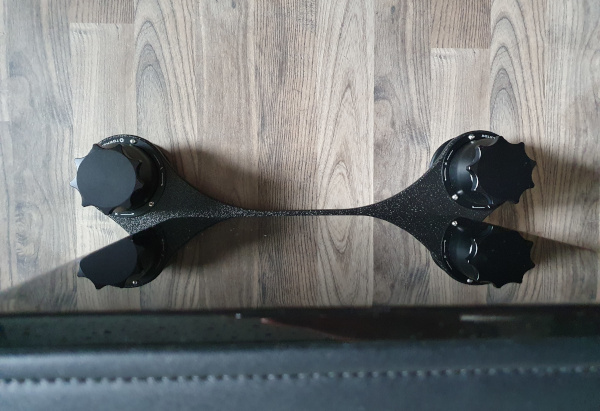
Similar benefits were heard with the Seismic Podium under the subwoofer. It improved the bass accuracy and timing. The energy of the cabinet with a moving woofer was sucked by the corner pods obviously, as I could feel significantly less vibrations when I placed my hand on the subwoofer. When seated I also clearly felt that the floor is trembling less under my feet. It happened to me more than once that I actually stood up and went to check the subwoofer whether it was on, and because it always was on I touched the woofer’s cone (which fires to the floor) if it was moving. It was and I could hear the subwoofer in the music, but I could not sense it through the feet or through the armchair I was sitting in. The resonances simply disappeared or they were suppressed to a high degree at least. I used Android MyFrequency app’s accelerometer placed on top of the sub to check whether I could measure the difference. No matter how sensitive or insensitive this app is this is what I got:
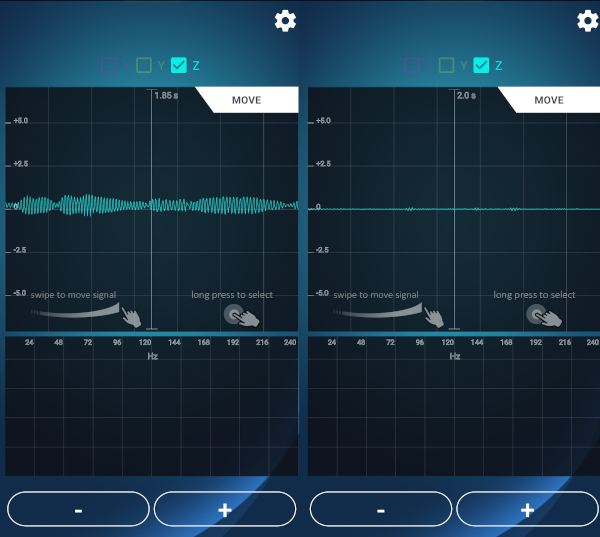
The resonance suppression like this is beyond the capability of the Ceraballs, Stillpoints and virtually any hard isolation device that I had tried. But can’t we achieve the same with sorbothane and other soft dampers that I disregarded earlier in this article? The difference that I hear is that the Townshend Audio Seismic Podiums don’t have any side effects like most soft isolators do. The moral is: those resonances that I felt with feet and palms travel through the floor and enter the electronics, including speakers. They can be picked up by sensitive circuits and crossovers, and I am not mentioning turntables. Now, when the floor is dead silent with the Seismic Podiums under speakers, aren’t we a step closer to what was encoded in the files or cut in grooves?
Synergistic Research UEF Cable Risers
Synergistic Research introduced their loudspeaker cable lifters as "UEF Cable Risers". Few weeks ago they were renamed to UEF Performance Elevators. They are simple cut outs from 2mm aluminum sheet, brushed and black anodized, with the SR´s logo. The variation on the Synergistic Research's HFT transducer is firmly attached to each lifter. I have been experimenting with the army of HFTs, ECTs and GCTs for over 4 months and can confirm that these are the most amazing tweaks I have ever tried in my listening room. Synergistic Research recommends to place the cable risers so that the HFT faces the listener; this is a rather difficult advice to follow - if your rack is more or less in line with your speakers then, logically, the risers will not look at you. Still, there is a difference in what you hear from speakers depending on to which direction the red cylinders fire. The UEF Cable Risers aka Performance Elevators are nice to look at, although the cut outs for their perpendicular supports have variable width so have to push hard to assemble some risers, whereas others were loose and disintegrated easily.
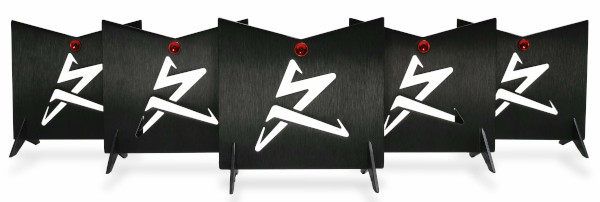
With the UEF Performance Elevators (Cable Risers) I replaced my own DIY set of cable supports that I finetuned during last year's lockdown period. If I should compare the UEF elevators to no supports (that is to the cables laid on floor or placed on usual homemade tweaks like toilet paper tubes or wooden blocks) there are several remarkable improvements to the sound. First, the sound gets focused. It is as if the camera lenses went from rather soft and blurry image to super-focus.
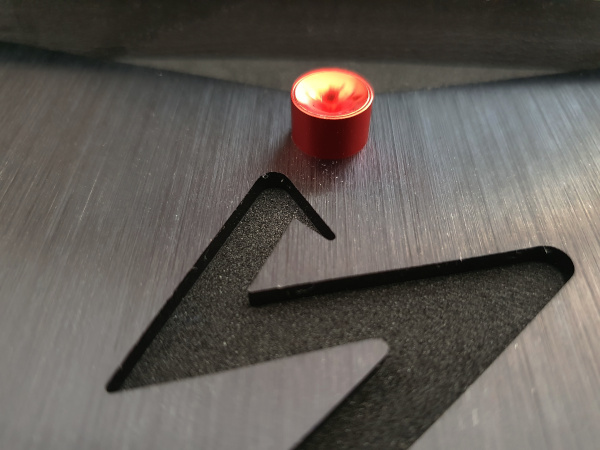
Second, the soundstage gets closer and more physical. Especially the center images are more vivid, radiant and reach towards the listening position. Depending on what I listened to and how the recording was mixed it was a vocal, a trumpet, or a double bass that started to communicate more intensively.
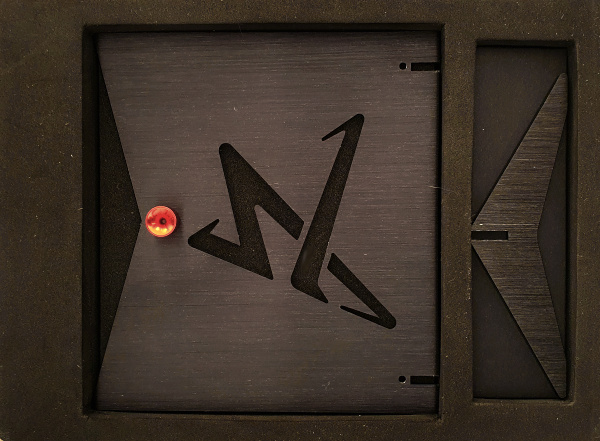
The UEF Performance Elevators are sold in the packs of four which is okay if your speaker cables are thick and rigid. For softer, pliable or long cables more sets will be needed. This increases the number of options how to fine tune the sound to your preferences by orienting the HFT transducers on risers to one direction or another.
Shunyata Research DF-SS Dark Field Suspension System
It has been just few months ago when I had Synergistic Research’s UEF cable risers in my system and here I am again, kneeling behind my speakers and sliding new Shunyata Research’s DF-SS elevators under speaker cables. The DF-SS stands for “Dark Field Suspension System”. Not that has the dark force been employed, the Dark Field denomination refers to the original polymer elevators that Shunyata has had on offer for hundred years or so. While the originals (now downscaled into what is called “Mini”) were just triple-layer supports that should minimize static fields between the floor and a cable (or between two cables), the new DF-SS is a more elaborate product.
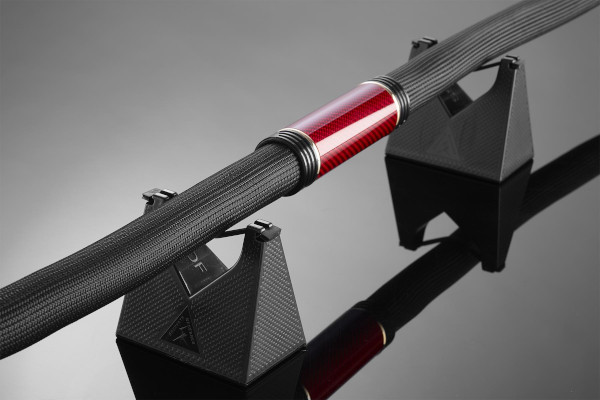
It also relies on static-neutralizing polymer but adds two other ‘noise suppression’ elements: the cavity of the elevator is filled with a granulate that should dissipate vibrational energy and thus decoupling the cable from the floor, and a cable is suspended on a rubber strip stretched across the “V” legs of the DF-SS. According to Shunyata the DF-SS elevators “render a significant reduction in perceived noise and time smear, yielding improved focus, clarity, depth and spatial information”. I had several sets (they are sold in packs of 3) of the DF-SS available and used them under speaker cables, interconnects, and power cables over course of 10 weeks.
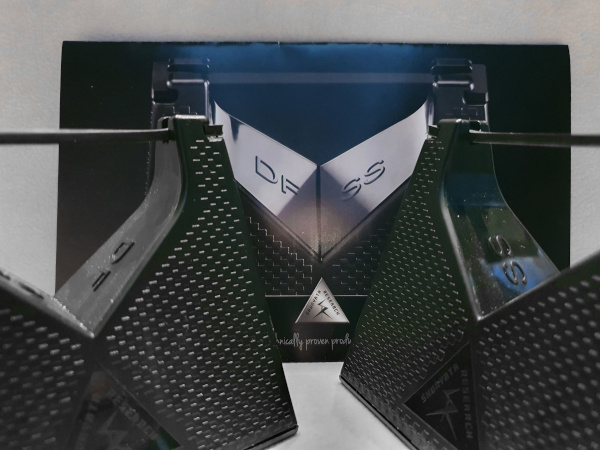
Unlike the Synergistic’s UEF cable supports the Shunyata’s DF-SSs are not such show-offs. The effect if the DF-SS is rather subtle in terms of a casual before/after comparison, yet it is more profound long-term. After I inserted the UEF risers in my system I got that impression of improved focus and vividness – combined with more forward presentation – right away and it stayed, without further improving. The DF-SS did not provide any jaw-dropping effect, but they grew on me. When I did quick comparisons with and without the DF-SS, I was not sure I was hearing a major difference. But when I left them in place for a week and only then removed them, the music suffered.
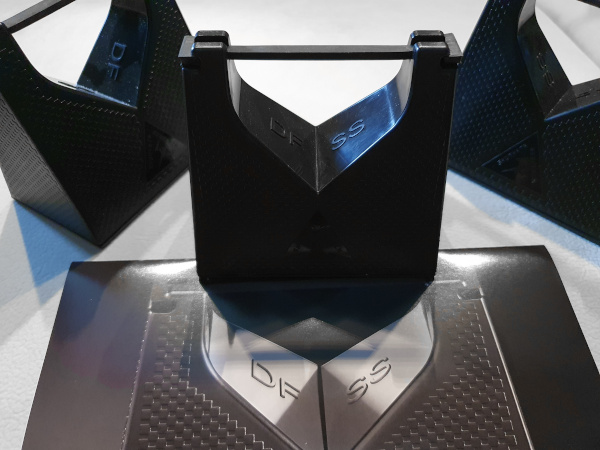
With the Shunyata Research DF-SS I did not find any changes in tonal balance that would make the sound jump out from the speakers, or become more focused, or vivid. Instead, the DF-SS as if removed invisible strings that were holding the sound back. I experienced lower noise floor, everything except the recorded sounds became quitter and less fuzzy. Actually, it was not unlike the difference between listening to the audio system during the day and at nighttime. The sounds were more distinct with subtle details more audible, and the sound acquired better liquidity and self-confidence.
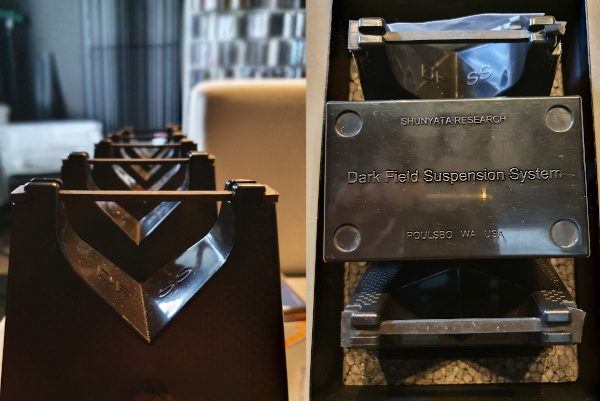
I do not know how to objectively measure the liquidity and self-confidence of an audio system playing back the music, yet I know that when all the DF-SS were removed the music lacked the lifelike quality that had been there before. Although the DF-SS are not cheap they are the most effective way of supporting audio cables known to me to date. Oh yes, and the Shunyata DF-SS is a very stable support that stays put thanks to its wide base, low center of gravity, and elastic suspension. A fantastic product.
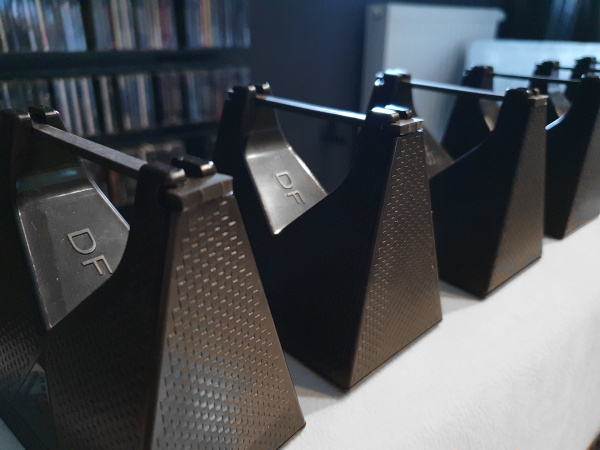
Synergistic Research MiG 2.0, Stillpoints Ultra 6 V2, AAI Maxi
The audio exploration never stops. Another month and here I am, my back bent behind the electronics again, my hands trying to swap the feet under the chassis (until now I did not know that the singular and the plural of this world are the same in writing, although the pronunciation differs; cha-sē for singular, cha-sēz for plural). Stillpoints have launched their improved version of Ultra 6, now marked as Ultra 6 V2; in Synergistic Research they have improved the existing model of MiG footers into MiG 2.0; Authentic Audio Image is a newcomer - the company has recently launched three models of component supports, Mini, Midi, and Maxi.
MiG 2.0: pin-point and unpin-point as you like
The MiG 2.0 stands for “mechanical interface ground” and in fact it is not a decoupling device, quite opposite: it is meant to be a resonant bridge between an audio component and the platform it rests on. Well, another fact is that all feet are resonant bridges, but here the function is accentuated by the inclusion of a HFT (high frequency transducer) that enhances airy side of sound (the HFTs have been discussed in length in our review, as well as they are a part of Synergistic’s UEF cable risers which are reviewed elsewhere in this article).
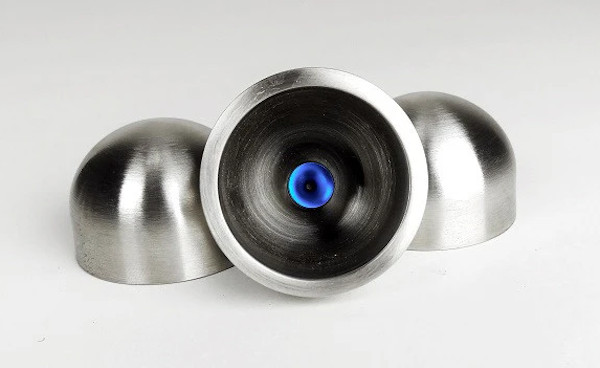
In essence, the MiG 2.0s are stainless steel bowls that have the sound of their own (when hit by a pencil, for instance), and should be placed under a piece of electronics in combined fashion. Ted Denney, the designer of MiG 2.0s, suggests to use 3 MiGs – two round side up and one round side down for “ambient soundscape”, two round side down and one round side up for “pin-point imaging”.
It has been since long time ago that I stopped chuckling after reading Synergistic Research’s claims: every single device from SR that I tried in the past worked exactly like advertised, no matter how unbelievable its claim was. The MiG 2.0s were designed to work in synergy with Synergistic’s Tranquility isolation platforms. These were also available at the time of this review, however I wanted to know what the contribution of the feet is, and not that of the complete isolation solution.
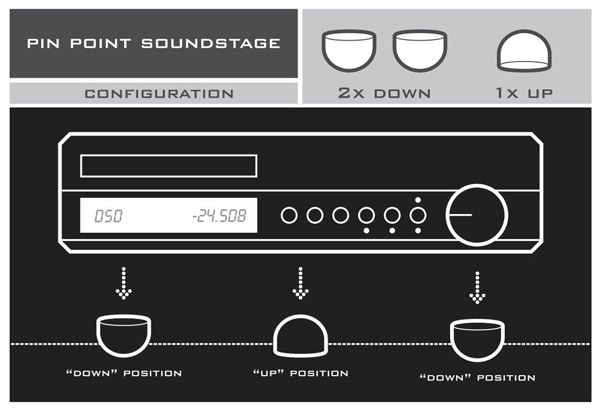
The one up and two down scheme under my amplifier produced slightly drier sound that I am used to with Stillpoints (for some reason I keep using Stillpoints Ultra Mini in this particular application). And yes, the outlines of images got sharper and transients more scalpel-like. This suited well typical audiophile numbers like female vocals accompanied by a bass and drums. The less instruments in the mix, the better the MiG 2.0s made each stand out. With classical cuts, as well as with layered electronic music, the focusing effect was too much to my taste and I preferred the inverse placement, one down and two up. This produced audibly more diffuse soundstage, not unsimilar to what I heard with HFT Wide Angle transducers during my experiments with the HFTs. Still, in no combination under the components the MiG 2.0s bested the Stillpoints. Then I got an idea.
As mentioned, the MiG 2.0s are resonating bowls. There are similar legitimate devices like that on the market, e.g. from Acoustic Systems International or from High End Novum. The fundamental resonant frequency of the MiG 2.0 is somewhere around 7.3kHz (plus harmonics), that is between the presence and the air region of the frequency response. Aided by the transducer inside the MiG’s bowl transmits high frequency energy that couples with room’s resonant modes and affects what we hear. So I spent three days by placing the MiG 2.0s on various surfaces in the listening room and listened to music.
Long story short: it works better than I would imagine. Each room is individual so probably it makes no sense to describe in detail what I heard in which position. The best placement I identified in those three days was on the speakers, the round side down, one on each speaker (another good placement was behind the listening position, one third of the length from the ceiling).
On the Concierto de Aranjuez from Accuphase Special Sound Selection 4 sampler the soundstage got more alive, the decays were longer and more natural, and imaging became fantastic. There was no trade off, the acoustic instruments, voices, and claps and stomps in this live recording sounded much more real, much more palpable. On another track, Tchaikovsky’s Swan Lake transcribed for two pianos, the piano exhibited better microdynamics, the sound was more open, and the hammers hitting the strings were better resolved. The soundstage acquired more depth, and the relative positions of both pianos became better delineated. I could further fine tune the result by moving the MiG on each speaker towards me or farther away from me, always centered on drivers center.
The MiG 2.0s rounded side was quite slippery on the top of the speakers and using a double-sided tape or blu-tack was not a good idea as the resonant behaviour of the bowl was damped. To be able to employ this solution permanently, the MiGs must be anchored by some metal element, like a shallow metal tripod or similar.
Stillpoints Ultra 6 V2: richness and focus
The Ultra 6 V2 is the most advanced decoupling device that Stillpoints make today. It is the heaviest too, 680g each. In this article series I highlighted already that the hierarchy is clearly given in the catalogue of Stillpoints – the bigger and more elaborate the decoupling device is, the more you can expect. I also noted that the main difference vs the lower-in-the-range version is the fullness and completeness of the sound.
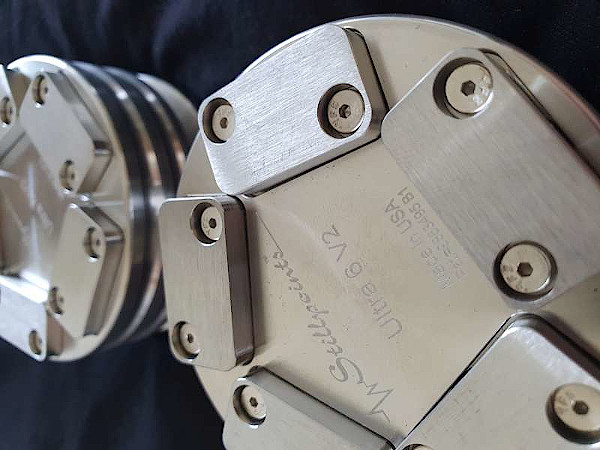
It is not different with Ultra 6 V2s that feature 6 layers of ceramic balls in a body that consists of several stainless-steel segments, thus giving the whole assembly wobbly feeling, that is exactly what is desirable for perfect decoupling. The Ultra 6 V2s can be used under anything, including subwoofers and speakers.
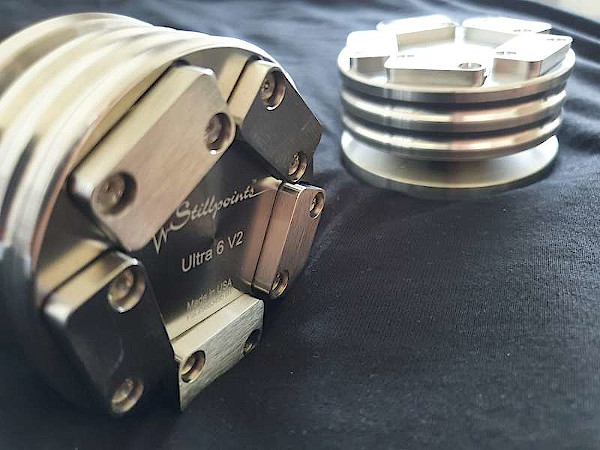
Like all Stillpoints the Ultra 6 V2s also add a quantum of presence to the sound, so everything gets clearer and more vivid. The instruments and voices snap into focus, the level of detail increases, and bass improves its contours. At the same time, the 6 V2s improve the tonal density and the sound gets richer, more harmonious, and fuller. The Stillpoints Ultra 6 V2s are incredible feet, exactly as expected, although they are on the expensive side.
AAI Maxi: power and stability
The contender for Stillpoints has emerged from Slovakia. Although Authentic Audio Image do not organize the massive marketing like renowned audio brands, the good news is that all three guys behind the brand are active classical musicians with trained ears.
The AAI supports employ the usual ceramic-balls-inside solution, 5 balls in two layers in each. Two stainless steel segments are floating on each other like they do in the Stillpoints. On top of the mechanics, Authentic Audio Image adds their proprietary “IST” treatment (the acronym stands for Interference Suppression Technology) that is the core of the Maxi´s performance. The authors say that in case a skillful DIYer opened and reverse-engineered the feet, he would not be able to achieve the same performance due to the missing IST step.
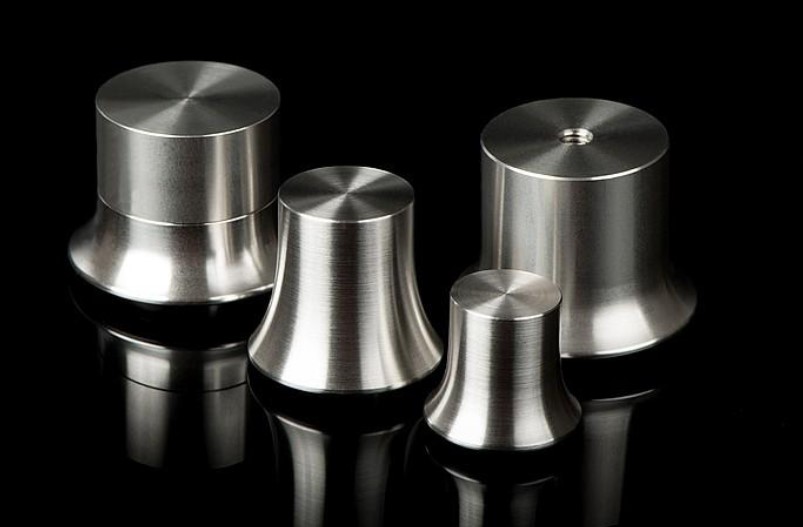
The AAI Maxi’s height cannot be adjusted (for this you need to get adjustable Maxi Plus), however it is recommended to use 4 units under a piece of electronics for best results. Not only does the component get stable on Maxis – the sound gets too. Like with AAI’s Maestoso power cable the effect of the Maxis was evenly spread over all the important attributes of high-end listening. That means there is no favoritism, no preferential treatment to one at the expense of another. While the aforementioned Stillpoints Ultra 6 V2 may generate a bigger wow effect, after days of listening the Maxis I can declare them almost equal.
Megadeth and their Unplugged in Philly is a bootleg album of the group’s acoustic tour in June 1998. The recording has exquisite dynamic headroom (22dB) and cannot be more authentic. It is not an audiophile recording as such and especially the stereo is quite narrow as if the set was one-miked from a distance. Yet, with the AAI Maxi feet under my power amplifier, the soundstage and the sounds became perfectly legible, and no matter how many times I listened to Countdown to Extinction I always found some new details that had been either completely hidden or not clearly heard before.
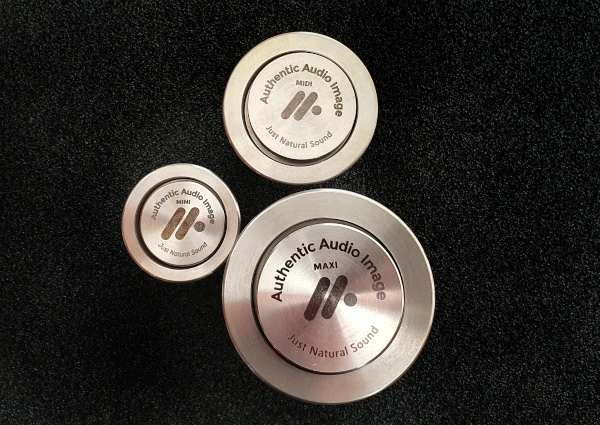
In Ringing That Lonesome Bell (AudioQuest Music) Robert Lucas sits on a highchair, with the microphone at chest level and capsule firing up towards a pair of overhead microphones. This vertical arrangement and relations of the mics, the guitar and the singer, can be heard with standard feet too but it is only with the AAI Maxis that the live-to-two-tracks recording really gets alive and the soundstage layout becomes holographic and exact. The AAI Maxis also helped timbre of violin in Number Two better develop (#5 on The Hot Club of San Francisco album from Reference Recordings). The wide spectrum of expression on this track seemed to be heightened and I had a stronger feeling of amazing musicians having a good time in the studio. The double-bass solo towards the end of the track acquired better gravity and the bottom end had a solidity and power that anchored the music.
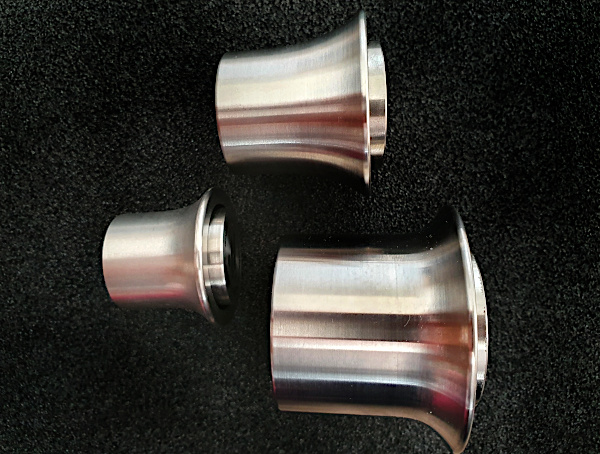
The same power, musical warmth, and envelopment entangled me on Emel Mathlouthi’s Kelmti Horra album (World Village/Harmonia Mundi). The Tunisian singer’s mesmerizing music combines traditional Arabic motifs with modern production (beats) and acoustic instruments (guitars, violins, various percussive instruments). This music is rich in transients and the Authentic Audio Image´s feet made all the snaps, strums, pops both articulate and fluid at the same time. During weeks I used the Maxis and Midis under thirteen amplifiers, DACs, and players. I hope that all readers of this lengthy article have already stopped using soft feet under components. If not, and think that Stillpoints are beyond your budget, try the AAI. From all I have ever tried, the AAI feet are the closest performer. There is still an audible superiority of the Stillpoints, especially in how they handle the outlines of sonic images; however, this only applies when the AAI Maxis (250€/pc) are compared to the Ultra 6 V2 (1,000€/pc). In fact, I should compare the AAIs to the Stillpoints Ultra SS (275€/pc), however, there is nothing to compare - the Maxis are vastly superior.
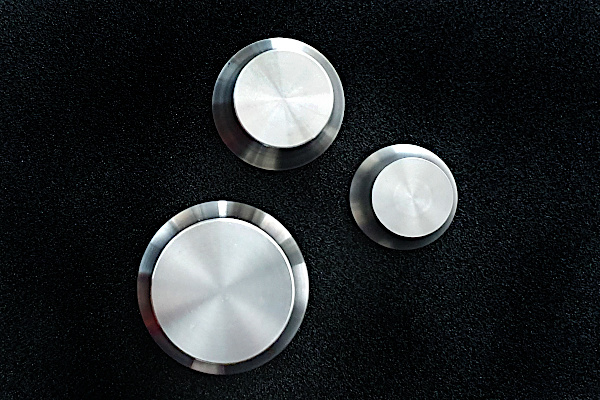
For I keep using Stillpoints Ultra Minis (140€/pc) under power cables with success, I swapped them with the AAI Minis. Well, I can say that from now on I am using a combination of the Stillpoints and the AAIs under the cables. Not easy as both the devices are wobbly and to keep a cable on the top of the smooth stainless steel surface needs careful balancing. But perhaps it is the wobbly nature of the devices that isolates the cables better from floor-borne resonances? Who knows? The good news is that in Authentic Audio Image they are working on the Minis with a cradle-shaped top part to prevent the cable slip away.
Korean precision
I have been a keen follower of Korean Hifistay project since 2003. I can't believe it has been 20 years already. The company was dealing with CNC manufacturing of ultra-precision parts for various industries, especially optical devices, and the Hi-Fi range was basically a hobby back then. It all started with various aluminum platforms and racks, the design of which I literally drooled over. I was determined to buy something, but outside Asia the products were unavailable, the Hifistay website was very messy and in Korean, and the convenience of today's internet was still in its infancy. My Korean was poor, so I was left damned to drooling only.
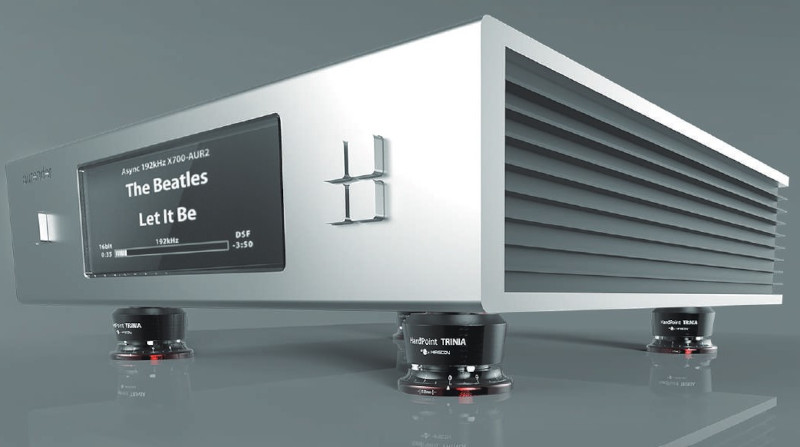
Over time, the gap in the after-market of electronics supports and isolators has been filled, but Hifistay - at least for me – has remained a kind of design benchmark. That's why I was pleased when the company started exhibiting at High End Munich - it signaled a serious effort to expand outside Asia. They succeeded, and so ended up playing with three different Hifistay feet sets - Hardpoint Trinia, Ballerino 60 Single Swing and Ballerino 88 Triple Swing - at home in my own and other audio systems.
Hifistay's catalogue is quite extensive and includes speaker cable lifters and turntable clamps in addition to component and speaker isolation feet, platforms and racks. All solutions employ quite a complex assembly of one or more layers of ceramic and/or alloy balls, silicone bands and floating discs; depending on the complexity of the applied solution, they allow the component resting on the feet to travel in one, two or all three axes of motion. Interestingly, the company uses hard-anodized aluminum. Compared to the stainless-steel Stillpoints or the AAIs, the Hifistays are much lighter, so they don't overload the rack or shelf. Unlike the competition, Hifistay sees no issue in publishing exploded views of their solutions, and each of their feet can be disassembled to individual elements. This is a rare example of open books in the high-end world.
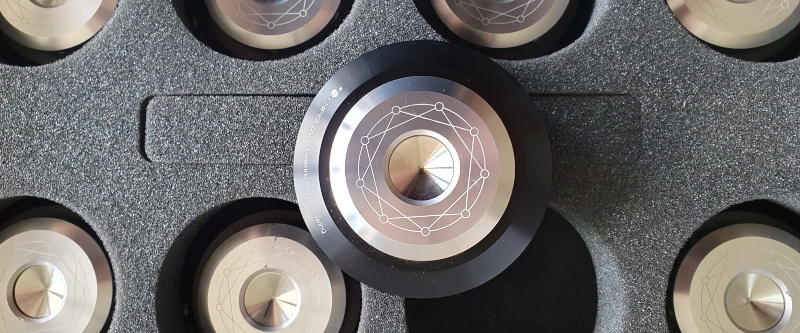
As usual, I spread a plan of action over several weeks and step by step tried all three types of the feet in all sorts of possible and highly obscure configurations, and with tons of music. I must make one point again: my findings can only be interpreted with caution, for each audio set-up is unique and has to deal with different challenges in the floor - rack - components - cables - speakers resonance system; and each of us has different listening preferences, and physical abilities to perceive sound too. Of course, visual impression also may play an important role, and here I can say that if any isolators have ever looked sexy, they are the ones from Hifistay.
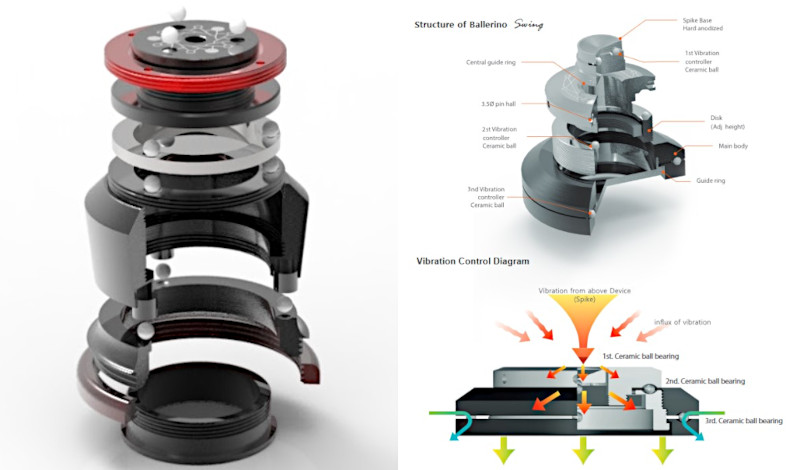
The Ballerino 88 Triple Swing is the company's most advanced model, existing in 80/88/130 versions depending on load capacity and size. The cool thing is that like all other Hifistay, the Triple Swing’s height can be easily adjusted – here it happens by turning the top ring. This is already a big advantage, as the competitors have limited or no height adjustability. If you are going to use the highest height possible, at least leave a safety margin of 2-3 turns/threads so the top floating segment has something to rest on. Conversely, if you set them down in to the lowest height, leave one thread spare - it helps floating work.
If you use the Triple Swing with spiked loudspeakers, each spike will fit into a tapered floating recess on the top of the feet. Hifistay also offers various adapters and spacers that simply connect the Ballerino to speakers or components via the M8 thread. I rather recommend the latter solution, as this gives you an extra floating layer and the spikes as such do not add any extra value. Of course, the feet can be used as flat pads under a speaker’s cabinet or a piece of electronics without adapters or spikes, but I don't recommend to do so. The Triple Swing’s upper floating tapered cone remains unloaded this way and it will resonate and rattle when playing music loudly. This means that with the Hifistay accessories one has to plan ahead and think well where and how the feet will be placed to choose the appropriate feet termination. Similar design principles are used in the Ballerino Single Swing and the Hardpoint Trinia ranges, which are primarily designed for less weighty components, like preamps, DACs and players. However, the load capacity per piece is still high (even the Trinia feet can carry 30kg each), so there are no real limits except too heavy equipment. Hifistay are thus probably one of the most versatile audio equipment support solutions on the market.
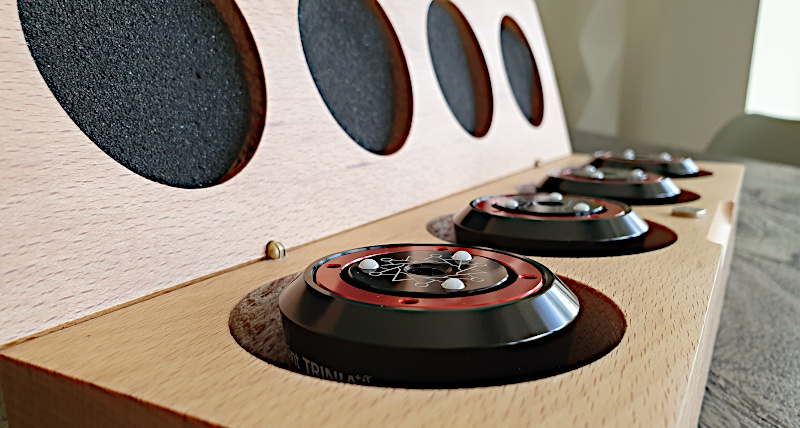
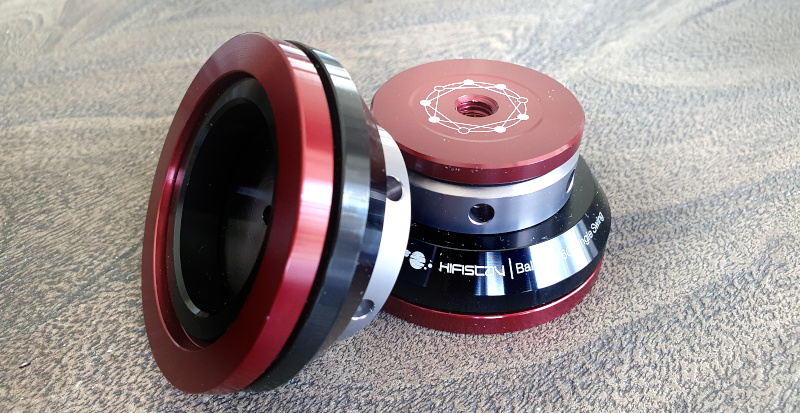
The relative differences between the Hifistay isolators can be easily demonstrated on an acoustic music piece, such as the playful jazz variation Phoebe's Samba performed by Benny Green (piano), David Wong (bass) and Kenny Washington (drums), as found on the album Live in Santa Cruz (Sunnyside Records). It is a live recording from a small club, Kuumbwa Jazz Center, a spontaneous performance to celebrate Green's 50th birthday in April 2013. It's also a bottom-heavy recording with a heavy emphasis on bass and kick drum, and it tends to sound dark in my own system. To improve the sound I’d wish for the following: The bass should remain deep but should be contoured better. The piano should remain colorful but with better dynamic attack. Overall, I would like to have more separation of the three instruments and a deeper look into the audience. That's the wish list. Can any of the Hifistay units do something about it?
With the Ballerino 88 Triple Swing, the rhythm section in Phoebe's Samba got tighter and the bass drier, and the percussion - especially the small drums and sticks on cymbals – better defined and dynamic. The shifts in sound were rather subtle, but still easily audible. It's as if the Triple Swing equalized the reverb across the frequency spectrum, with the bottom end reverberating shorter (thus clearing some of the darkness), and the top end taking extra headroom. I was expecting a similar effect from the Single Swing, just to a slightly lesser degree, but their effect went in a different direction. The Ballerino 60 Single Swing seemed to allow the speakers to work with a wider range of colours, as if more shades had been added to the previous colour palette. My wish for better separation was fulfilled - instruments became clearly better defined within a now slightly wider, deeper, and more importantly, more transparent soundstage. On the piano - recorded with a near-field microphone technique - I could clearly hear the spatial layout of the strings. Also, the harmonics of the piano’s individual notes got better developed, perhaps the best I’ve ever heard with any isolators. Under the components, the effect was surprisingly very similar and, in the end, better than the Sort Kones that the Ballerino 60 Single Swing replaced for the purpose of the test. Also, it was much easier to install more than 3 pieces under a chassis, because of the easy height adjustability which Nordost could not provide. In addition, the upper wobbly conical single ball platform on the Hifistay will level out any surface inclination irregularities.
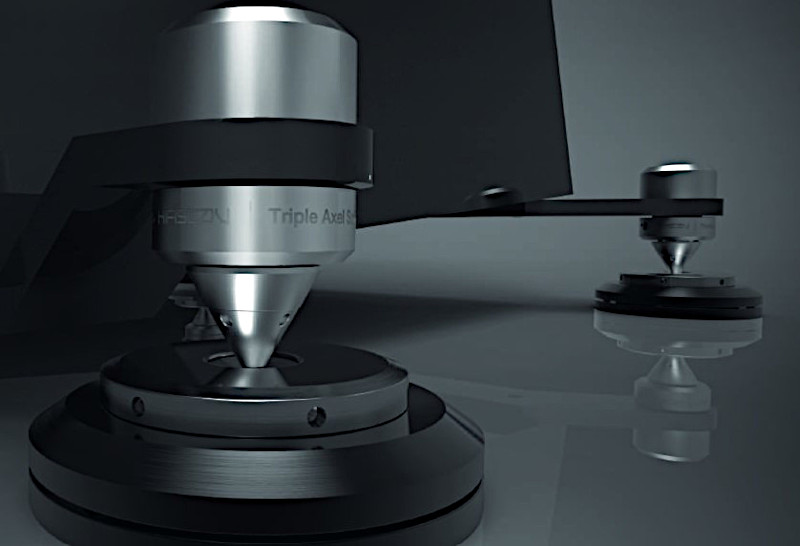
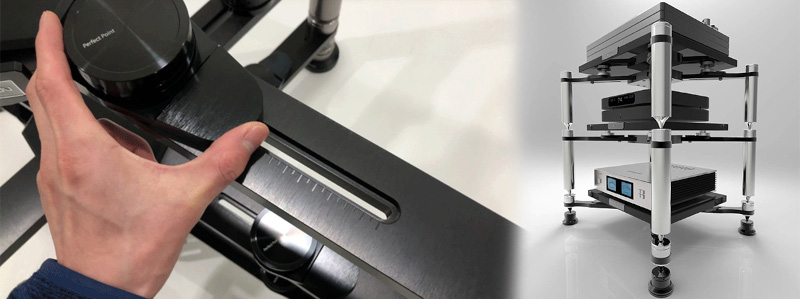
The Hardpoint Trinia, regardless of what they were put under, gave me the best mechanical confidence subjectively. The Hardpoint's are not primarily designed for under loudspeakers, and they are quite tall too, so I didn't even try them there, but all my components 'floated' beautifully on them. In other words, when I touched a piece of equipment floating on the Trinia , it was like it was placed on jelly. Logically, it was telling me that this is exactly how it should be. Unfortunately, logic is a short-lived thing in hifi - after all, sorbothan provides a similar feeling and the result is less than satisfactory. So, what was the contribution of the Hardpoint Trinia to sound?
The Hardpoints calmed the sound down and let it flow smoother. Where the Ballerinos were focused on rendering leading edges and attack, the Trinia's were more about sustain and decay, focusing on the note's demise, not its rise. The transients appeared rounder and softer, and this slight blurring made the bottom end fatter and more attractive to some extent. The top end got more velvety and smoother, as if silver became gold, and everything was just more fluid and warmer, more intimate. If you are a total bass control freak, the Hardpoint won't assist, but it can enhance the flow of music. I definitely recommend trying it out under source components like a DAC or a turntable.
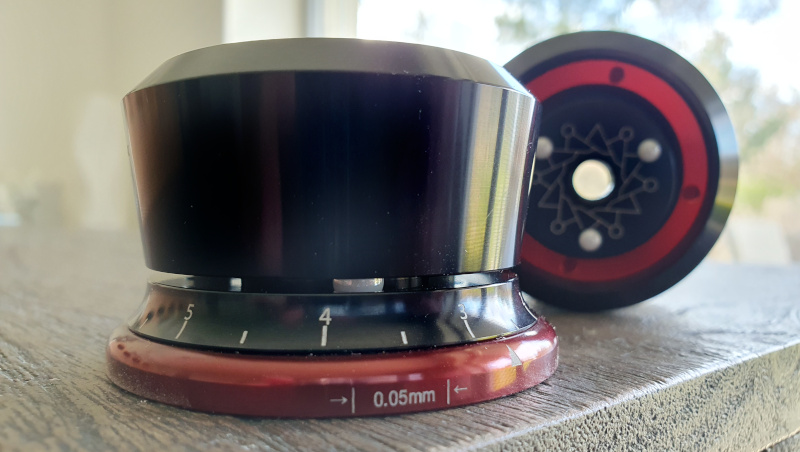
The differences between individual models of the Hifistay feet are not a sort of "more expensive and more complex provides more of the same". Each series is unique and manifests itself differently. This opens the possibility of custom voicing, using perhaps a one type of Hifistay under one component, and other type under another. The Hifistays are certainly not cheap, but what you get is an advanced and complex resonance suppression system, and stunning CNC workmanship. Too bad I don't have the components stored in a rack - their Mythology X-Transform rack is exactly what I was drooling over twenty years ago.
AAI ULTRA 4th Generation
Unlike most isolation feet that we've ever mentioned till this point, the AAI Ultra 4 do not even try to look hi-tech (or fetish for some). Each unit is a carefully milled stainless steel cylinder, in either natural steel or black finish, measuring 39mm high and 50mm in diameter. That's about it - there are no visible springs, rubber segments, dampers or attractive engravings. Yet, the Ultra 4's ultimate minimalism is simple and timeless. But boy, are they heavy.
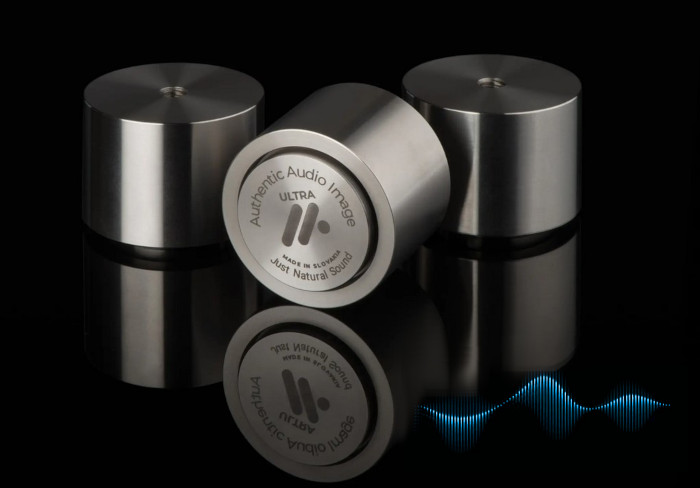
Weighing in at 547g each, they feel very substantial in hand and anchor well to any surface. There is no way to get inside, as the base and top are pressed together to form a single unit. However, when you touch the base, it wiggles and dances freely in all directions and you can feel - rather than hear - the rolling ball segments inside. If you need to fix the Ultra 4 to a loudspeaker or component, there is also an M8 threaded version. Should you need a different thread size, just let AAI know. There is also a cable-support version, but more on that later.
The fact that their height cannot be adjusted is a main disadvantage of the AAI Ultra 4, as is with all other feet in the AAI’s line up. To level a component or a speaker on four AAIs requires a perfectly flat shelf or floor, and also the flat bottom of the component or the speaker. You may be wondering why presumably flat surfaces should not be flat, but often they are not; the chasses may flex under the weight of transformers, wood panels extend and shrink due to humidity changes and tend to bend over time, and thin metal plates often deform. In case the component is not stable on four Ultra 4, you'll have to use some sort of thin spacer between the top of the feet and the supported piece of gear. A good trick is, for example, a piece of folded sandpaper, where you can adjust the thickness precisely in micrometres by selecting the right grit. Make sure you don't insert pieces of rubber, felt or other elastic material in there. All hassle is eliminated if you use three feet only, on which anything self-levels. Personally, I use the three-point anchoring under speakers and amplifiers and have never had a slightest issue. The load capacity of the AAI Ultra 4 is more than adequate (300 kg each) and if you doubt it, check out the picture where the concert grand piano is separated from the floor using the pods with AAI Maxi (which are smaller than the Ultra).
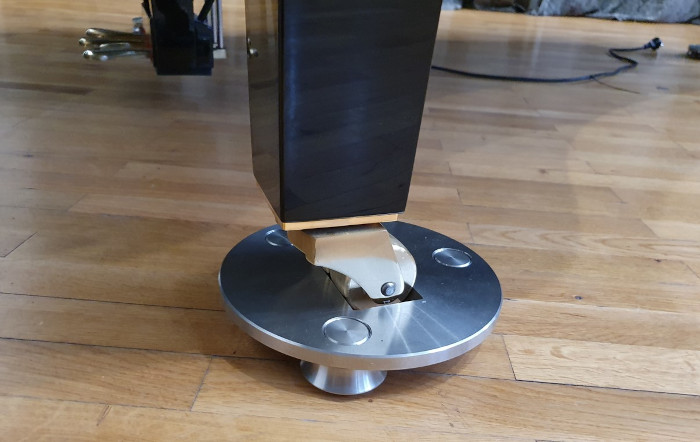
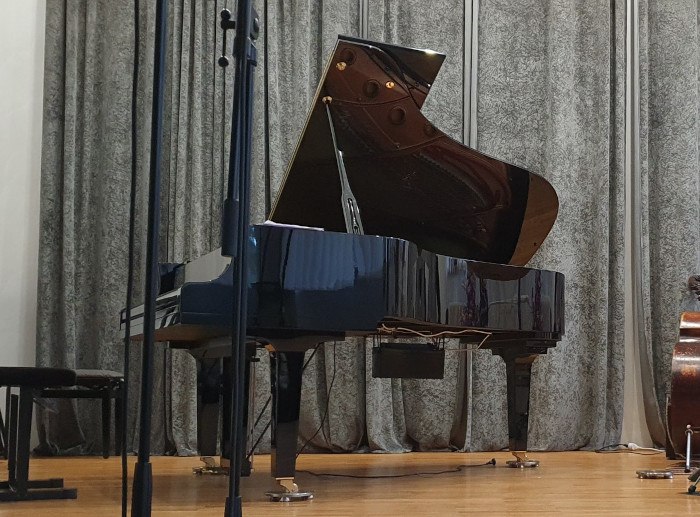
Inside, outside, and live.
The Ultra 4s excel on voices. In this respect they are not so different from previous generations of AAI. The Ultra 4s under my power amp 'render' male and female vocals beautifully three-dimensional and very lifelike. AAI have already proven that they know how to achieve this outstanding holography and here it is again; it feels like the performer is with you in the room, in realistic width, height and depth. The AAIs do not make the image bigger than it should be, nor do they miniaturise it. Although I mentioned earlier that I normally only use three pads/feet under the electronics and speakers, I must admit that having four units of the Ultra 4 is better than having only three. This has been proven time and time again with every component I have placed on the Ultras. Of course, it also depends on the design of the component, but I would not say that better made components get less benefit. For example, my Accuphase DP-720 player is built like a tank, and yet I achieved the best results with 5(!) components underneath its chassis. However, levelling five non-adjustable feet was quite a challenge.
Another important feature of the AAI Ultra, for me at least, is how musical they are. It's hard to pinpoint exactly what causes musicality or non-musicality - I think it's probably a combination of not overemphasising one frequency band at the expense of another, and maintaining the dynamics and timing that are important to the proper 'flow' of music. The ear is sensitive to these things and can evaluate them. But everyone's ears are different, so some listeners may prefer Stillpoints (which are admittably more more hi-fi) or Hifistay (which can help smooth out the things a bit), or anything else. The point is to make it all work together in the listening room. I like the AAI Ultra 4 because nothing is missing and everything is just right. The Ultra also have the ability to reveal subtle nuances. Again, without bringing them to the fore at the expense of the natural flow of the music. You can hear this beautifully on the metal of cymbals, for example, where the sound has a wonderful micro-detail, or on studio reverb, where the Ultra makes the reverb more pronounced and related to a specific instrument or voice, without overshadowing the primary instrument and voice - the reverb just makes them more lifelike.
Matching pads to a component is like matching a bike saddle to your butt: after a few minutes of riding you'll know if it's not the right one. This part is easy. But it is only after two or three hours in the saddle, or two or three weeks of listening, that you'll know if it is the right one. It's not uncommon that the initial impressive strengths develop into nuisance over time, and then you need to re-think the whole approach. Once the things click, you'll be enjoying the music and having fun with it for years. With the AAI Ultra 4 I've had no need to re-think anything, and they are still in my system although I am writing this text with a 6 month delay.
I've already made a comparison to the Stillpoints: the Americans are more accurate in the bass; not because the go ‘deeper’ but because they highlight its upper harmonics. At the bottom end, the AAI Ultra favours a rounded musicality, the Stillpoints are drier and punchier. It's all a matter of scale, of course - if you give a listen to a brass band on the street, the bottom end won't have much definition, but it will have dynamics we can only dream of in our home environment. So, think of the AAI as a kind of double bass played in the street.
Very Special Quartet is a jazz group consisting of Ondřej Štveráček (tenor and soprano saxophones), Tomáš Baroš (double bass), Klaudius Kováč (piano) and David Hodek (drums). Not only are these musicians par excellence who have worked with the world's jazz aces – they are also guys who are open to improvisation - after all, jazz is essentially one big improvisation, isn’t it?

So, here I'm in a small room with the Very Special Quartet and a piano anchored on the three AAI pods, and a double bass has its endpin spiked into a specially adapted AAI stainless steel pad. For the sake of comparisons, it is unthinkable to get the piano on and off the AAIs, however it is quite easy to remove the bass’s endpin from the pad and stick it to the wooden floor. And let me tell you, from the perspective of the listener in the audience, about three or four metres away from the ensemble, it's bloody audible. The piano exhibits beautiful colours and a solid definition, and the dance of the hammers on its strings is a mesmerising experience. The sound of the bass spiked into the AAI projects better into the room, it is punchier and more pronounced. When removed from the AAI pads and spiked into the floor, the sound as if closes in, it becomes softer, more boomy, and less enveloping. The second thing I noticed, closely related to the first, is how much the separation of instruments within the quartet improved with the AAIs. When all the musicians play together, the drums and saxophone dominate, for they are really loud. Although the piano can compete, the double bass has a hard time making itself heard. You know it is there, but it is rumbling the background. The endpin goes back to the pad and lo and behold - suddenly the bass is heard, suddenly it is an equal partner, you can admire its melodic line, no issue whatsoever. I love these real-life tests - I still remember putting the Synergistic Research HFT on my home piano and asking my kids to comment on differences. For them, they were easy to pinpoint. It's definitely better to experiment than to argue from behind the computer keyboard why this or that cannot work.
Alison Krauss loves AAI
So, what has happened to the AAI pads over the generations? It's a bit like moving from a lower-resolution camera to a higher-resolution one. You can live with the lower resolution without problems. The first-generation iPhone had a 2 megapixel camera and it was epic. Today's 15th generation has 48 megapixels and it's epic too. It all depends on the context of the times, the evolution of technology and the requirements of consumers. Sometimes progress may seem slow and insignificant, but when you have to downgrade, it seems next to impossible for you. AAI used the Ultra as a base and have converted the pad into a cable support, actually just by milling a round channel into its upper part. The cable supports are a new addition to the AAI portfolio and, of course, they too have undergone the IST material treatment - now in its 4th generation too. Don't ask me what that means, IST remains the company's know-how. All I'm interested in is the result and, more importantly, whether the new product has improved on its predecessors (yes, I tested all other AAI feet under cables too, although they were not aimed for this application).
I am pleased to say that the AAI Ultra 4 (under the speaker cables) behave like a much more superior camera lens. The recording space is audibly more accurate, the imaging is essentially superfine at micrometre scale, and the dynamic contrast is greatly improved. The change for the better was particularly pleasing on recordings with natural acoustics, such as Alison Krauss' Away Down The River, the piece that over the past two years has become a universally hated song by the rest of my family, for they hear it from my listening room over and over again; in fact, the reason I use it as one of my main test tracks is because I know where and how the musicians were positioned in the studio, where microphones were placed, and how the recording room was arranged and furnished. It's also a beautiful piece of music, so why not. It begins with a synchronised kick of drum and bass. So perfectly synchronised that on many audio playback chains it sounds like one instrument, not two. The tricky thing is that even with my setup, which I consider pretty decent, with certain types of feet/pads (I'm still talking about speaker cables) the two instruments merge into one. Not so with the AAI Ultra 4, where the separation between the two instruments is the clearest I've ever heard. With the AAI, the slight offset of the kick transients from the bass transients is easily audible, as is the better temporal separation of each instrument's dynamic envelope. It's a small thing, but the result is another step closer to the truth.
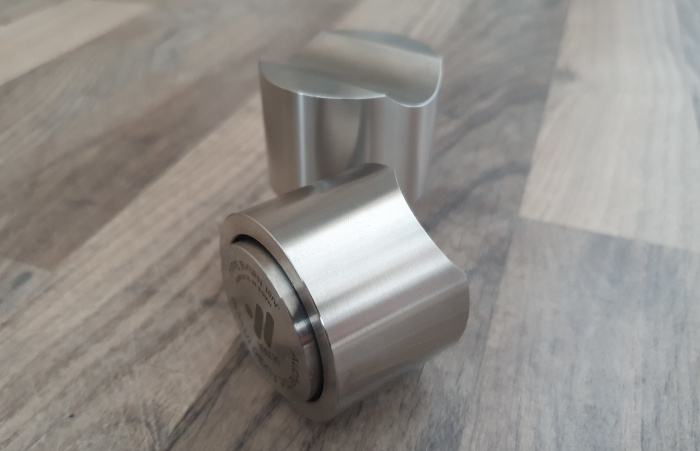
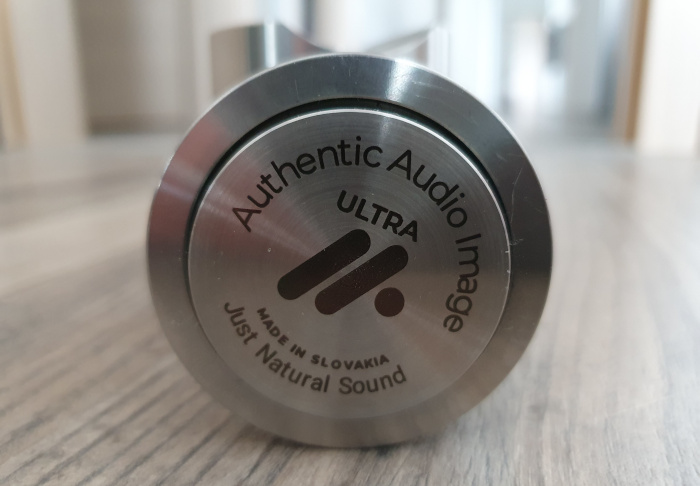
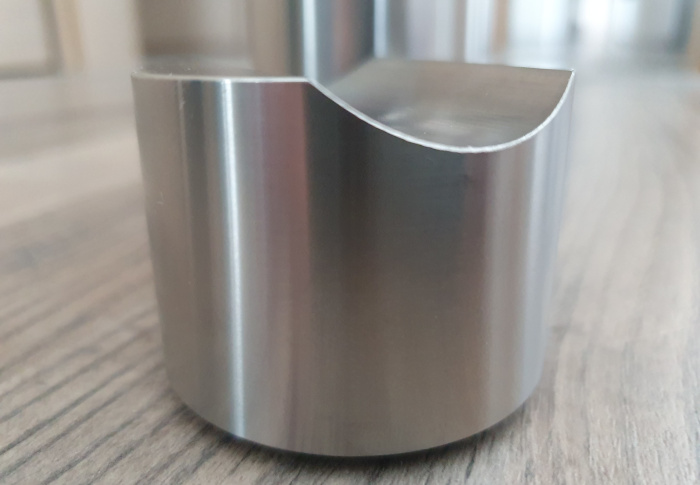
The Ultra 4 can also be used under power, signal or digital cables. The result can be literally fascinating, all it takes is patience and playing around with the placement. You'll probably have to move the pad a few centimetres to one side or the other until you find the point where it's perfect. If you have components stacked vertically in a rack or on a shelf, you can skip this part, however, you can experiment with them under the legs of the rack or shelves.
If you are intimate with your system, you can tell straight away whether the sound changes for better or for worse. For example, when I needed to raise one of the AAI cable supports by ca 0.5cm, I slipped a small square cut-out of carpet under it. The carpet sucked out the midrange and the bottom end started to sound muddy and smeared. Stacking two AAI's on top of each other (a very unstable design, by the way) did not work either, nor did turning the feet upside down. That's not to say it won't work for you, you'll just have to give it a try. Deeper and deeper I was getting into the experiments with the AAIs, I ended up removing all the other supports from the whole cable maze (a mix of Finite Elements, Stillpoints, and a couple of my own designs) and replacing them all with AAIs, with one sole exception: the Synergistic Research Atmosphere Level 2 power cord, no matter what, only accepts Stillpoints Ultra Mini - anything else ruins its performance.
Big guns
Naturally, I was curious to see how the AAI Ultra 4 would perform elsewhere, so I took it to three other mature systems. In the first one, the Ultra 4 went under Ayon CD-35 HF Edition SACD player. The AAI-assisted sound was a little softer, yet more open with more natural imaging. But the CD-35 was soft enough on its own and therefore benefited more from the Stillpoints, which added some punch and sparkle, although the Stillpoints eliminated some of the AAI´s insane imaging. Also, with the Stillpoins, the tonal spectrum got more blue than red. A good compromise for this particular application was a 50/50 mix, that is two AAI and two Stillpoints.
The AAI Ultra 4s under the EMM Labs DV2 DAC had a very positive effect, with bass becoming more refined, also midrange control got improved, and the music had overall better proportions, flow, and spatiality. In addition, the DV2 can be a little too forward for my taste, especially with dynamically flatter recordings, and the AAI Ultra 4s a sort of relaxed it into more digestible material.
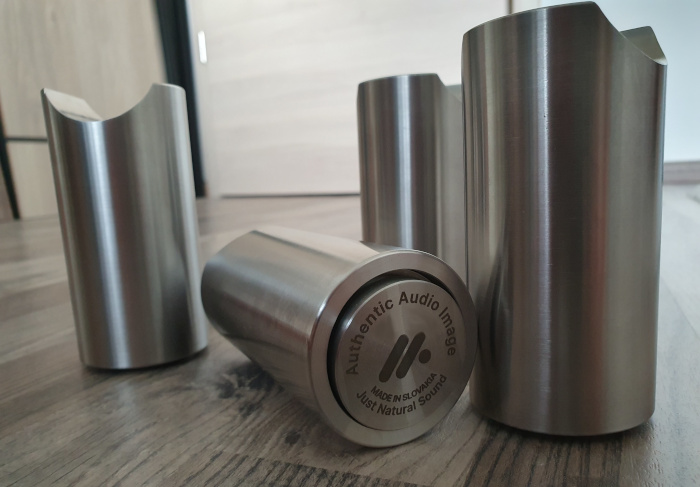
The sixty kilos of the BAT REX 500 stereo power amplifier should not be fazed by any feet. This device is like a concrete block and to expect four pieces of stainless steel to transform its sound seems foolish. However, exactly this happened, and the REX 500 was transformed. The beautifully holographic soundstage, the perfect transparency of the instruments, the amazing presence of Paul Desmond's alto saxophone, the perfect dynamics of the piano and drums - all took the experience of Brubeck's Time Out to a whole new level. It was interesting to hear how the cymbals had better defined initial transients and became more sonorous and therefore more audible in the mix with the AAI, but at the same time the amount of the highs, and therefore their relative weight in the mix, did not change. To be clear, the AAI did not add any brightness or spark, they just let the instrument shine. In retrospect, the most likely explanation is that the AAI - in addition to separating the instruments - allowed the amp to work with a wider dynamic range (by not draining the energy out), which, together with the very real imaging, produced the liveliness, as if the performer was in the room with you.
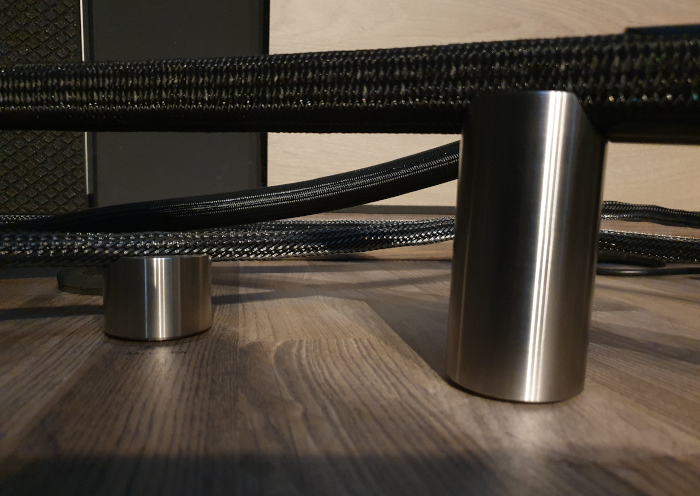
I'm not saying that the AAI Ultra 4 are the best feet/pads in the known universe – each audio set up is unique, as are preferences of the listeners. Just like carved maple blocks that work for some, and an elaborate titanium designs that will suit others. However, if you're serious about hi-fi, you should definitely give the new AAI Ultra Generation 4 a try, even if you've had experience with one of their previous models. It's like in the iPhone example above - it's still an iPhone, it just gets more advanced with each new generation and once you experience the new, downgrading is impossible.
December 2023 AAI update
Not even two months have passed since I complained about non-adjustability of the AAI Ultra 4 feet, and here I am, looking at a new version that is adjustable. This version of the feet is now split into two threaded parts; by turning the parts against each other the height changes. The AAIs in the picture are machined into a tapered shape - if you like to have them cylindrical, no problem. The way the feet contribute to the sound is not changed by the adjustability.
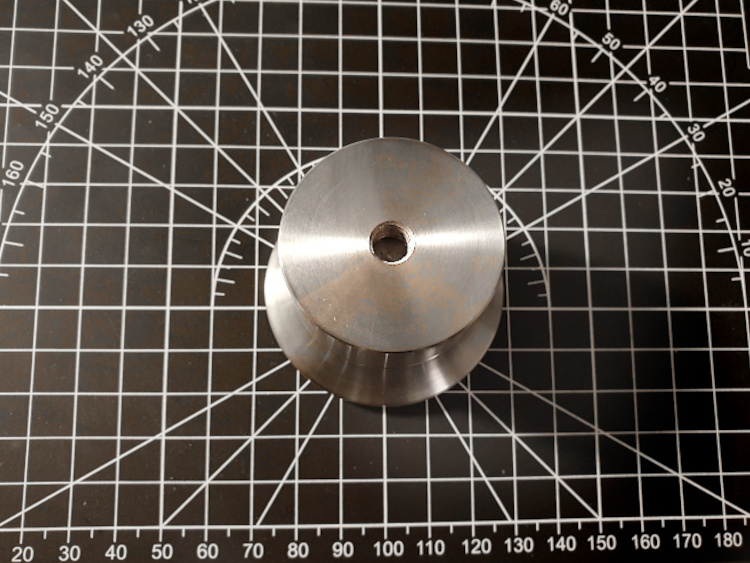
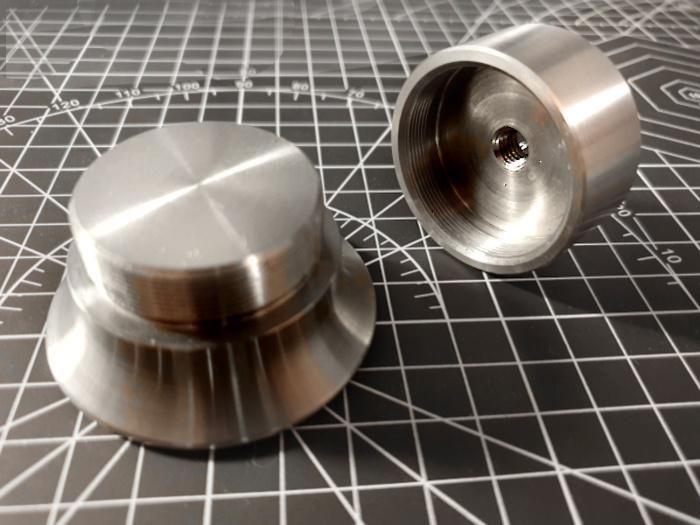
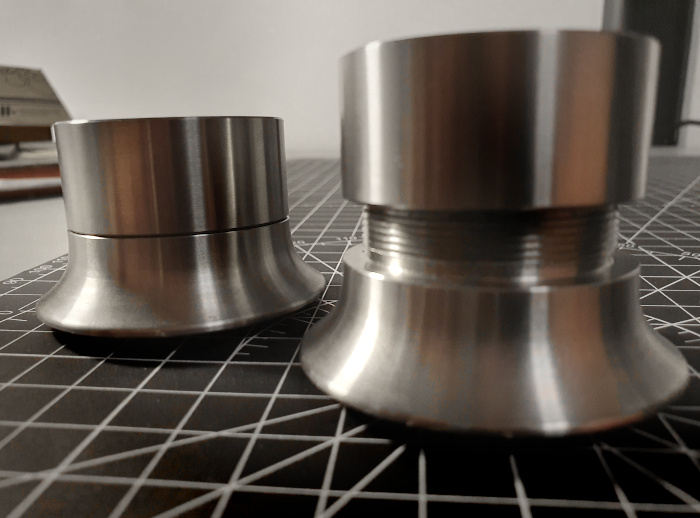
The adjustability range is quite generous, 10mm. Not that your rack or electronics are so out-of-level, but it can be very beneficial to use the AAI under the speakers and adjust the front to back tilt. This way the tweeter can be very precisely matched to you ears. AAI also provides the option of complete customization according to the client's needs - thumbs up for such flexibiity. Together with the adjustable versions some new prototypes have arrived, so stay tuned.
Stillpoints Ultra 6 V2 revisited
Another summer, another round of experiments. I have been running 3 pieces of Stillpoints Ultra Mini under my TAD power amplifier (43kg) since ages. The load capacity is not a problem, each of them is specified at 23kg. Originally, I had five of them under the TAD, but removed two and the sound got better, so I have settled on the three. Over years I tried many other aftermarket feet, supports, and platforms under the amp and always ended up with the Ultra Minis. The spicy fact is, that two years ago I tried to replace the Ultra Minis with Ultra 6 V2s. I liked what I heard, it was an improvement versus the Minis as I described earlier in this article. However, at the asking price of the Ultra V6 it made no sense to consider swapping permanently.
I am lucky that a good friend of mine runs something as a “Stillpoints Center”. He runs a showroom for the local distributor (Roth Audio) and no matter whether a loudspeaker, an amplifier, or a source component, everything is immediately placed on Stillpoints. I must admit, that although it borders obsession, there is always improvement to how the speakers or electronics sounded before the Stillpoints and after them. Perhaps a mug of coffee would taste better if placed on the Ultra 6 V2. At least there would be less ripples on top of the coffee during loud listening session. Often I find myself wondering, why equipment manufacturers try and put money into designing feet under the devices they make. No matter how elaborate the original feet were, Stillpoints always improved the sound.
Think about the Audia Flight Strumento No.8 monoblocks. They are 95kg heavy each. The audio circuits of the Strumento inhabit their own chassis that is nested in another chasiss that hosts power transformers. Both mechanical blocks are decoupled, and each has its own set of feet to suppress resonances. It is a unique concept, the problem solved. Then you slide the Stillpoints Ultra 6 V2s under the Strumento No.8s (and it does get expensive as you must support each chassis separately), and the sound improves.


Stillpoints Ultra 6 V2 under the dual-isolated Audia Flight Strumento No.8 monoblock chassis
Think about the WestminsterLab Quest preamplifier and Rei power amplifiers combo that I have reviewed recently. It uses solid brass feet that were developed and tuned specifically for these devices. Yet, as I wrote in the review “With three Stillpoints Ultra 6 V2 underneath each power amp, the WestminsterLabs have undergone perhaps the biggest transformation I've ever experienced with these feet. If you own a Quest or Rei or both, be sure to give it a try. If the results are equally positive, I guarantee you won't want to take them out again”.


Stillpoints Ultra 6 V2 under the curved Wadax Studio Player chassis.
Think about Wadax Studio Player, which is to me one of the best (if not the best) integrated source components available. It has well-thought feet too that make the player ‘float’ and decoupled from the surface it rests on. Use Stillpoints Ultra 6 V2 under it and the sound improves too.

These recent experiences were an impulse to try the Ultra 6 V2s again. I got 3 units from the Stillpoints Center, the goal was to give them another chance under the TAD amplifier. My audio set-up is pretty much stable over last 7 years, but due to redesigned crossovers its performance has grown significantly (read the full TAD Revolution One story here). The plan to replace the three Ultra Minis and to decide proved to be more challenging than I thought. The Ultra 6 V2 is a much bulkier feet than the Ultra Mini (76mm in diameter vs 25mm) and I could not center them the same way as the original feet of the TAD got in the way. It proved to be blessing in disguise as I had to move the Ultra 6s around. I already have got used to the fact that audio requires tons of patience and a systematic process to maximize results. Thus, the Sixtol Air Mover became my friend for the weekend. It is an air pump (an inflatable pillow) with 150kg load capacity that makes precise lifting possible, without sliding. I could move the Ultra 6 V2s around by increments to fine tune their locations. I ended up with two in front (that’s where the transformers and most of the TAD’s gravity is) and one towards the back of the chassis. Unlike the Ultra Minis, location of which was asymmetric, with Ultra 6 V2 I got the best result in (almost) symmetric placement.


Stillpoints Ultra 6 V2 under the TAD M2500 power amplifier
What am I getting with the Ultra 6 V2. More authority and scale, tighter bass, increased transparency without glare, a tad more explosive dynamics, and better stability of images. Are there any trade-offs? Nope. This time I won’t let them go. Does it mean that I have become a mature audiophile? Perhaps.
As a bonus, I got one more benefit: Better thermal management of the amplifier due to improved air circulation, as the gap between the bottom of the chassis and the platform increased. Also the contact surface with the chassis grew significantly larger. The Ultra Minis have a conical top piece, so the contact surface is not far from an inverted spike. With the Ultra 6 V2, the contact between the foot and the amplifier is mediated by five flat stainless-steel segments. As the bottom aluminium block of the TAD is flat too, the feet contact is large and gapless. This way the Stillpoints became an extension of the amp’s chassis. I rarely turn the amplifier off, and all three Stillpoints are quite warm - external heatsinks, if you like.

Stillpoints Ultra 6 V2 under the Accuphase DP-720 SACD player
I visited my Stillpoints Centre once again and dismantled the SACD player from existing feet (Nordost Sort Kones) to place the Ultra 6 V2 under it too. I’m going to spare you the whole process and tell you the result: There are 3 units under the player now and the sound has acquired phenomenal triaxial separation and accuracy (that is in lateral, vertical, and front-to-back soundstage), totally unbeatable articulation of images, together with more explosive dynamics and brilliancy. I can see much deeper into how the music tracks were built, too. I’ve been listening to my favourite playlist for three days in a row continuously and still am euphoric. Does owning Stillpoints Ultra 6 V2 mean I am finally a grown-up audiophile? Maybe…
A floating ending
This ending is a floating one as this article expands over time (you have probably noticed me referring to different electronics in my system in the course of this lengthy multireview). I kind like this as it always makes me go through what I already wrote about some isolation devices and recalibrate the benchmark. The exploration of how the resonances in an audio system can be manipulated to the benefit of the sound is a wonderful journey. Skeptics will not change their religion (perhaps until they experience it for themselves) and the rest of us will be happier.
AUDIODROM WOULD LIKE TO THANK TO ALL THE IMPORTERS, DISTRIBUTORS, AND RESELLERS, FOR THEIR KIND SUPPORT. THE BIGGEST THANKS GO TO:
Platan Audio, Hlohovec / Bratislava, tel. +421 905 409 802 (Stillpoints, Finite Elemente, HRS Harmonic Resolution Systems, Synergistic Research)
Perfect Sound Group, Praha, tel. +420 722 960 690 (Nordost Sort Kones)
RP Audio, Ostrava, +420 737 366 831 (Finite Elemente, Ansuz Darkz)
Audiostudio s.r.o., Olomouc, tel. +420 608 752 475 (Townshend Audio)
HI-FI studio TYKON, Ostrava, tel. +420 723 449 894 (Shunyata Research)
Roth Audio, Praha, +420 777 674 381 (Synergistic Research, Stillpoints)
Authentic Audio Image, Povážská Bystrica, tel. +421 905 694 943 (AAI)
Dreamaudio, Bratislava, tel. +421 907 838 806 (Hifistay)















